

Mass of Ages
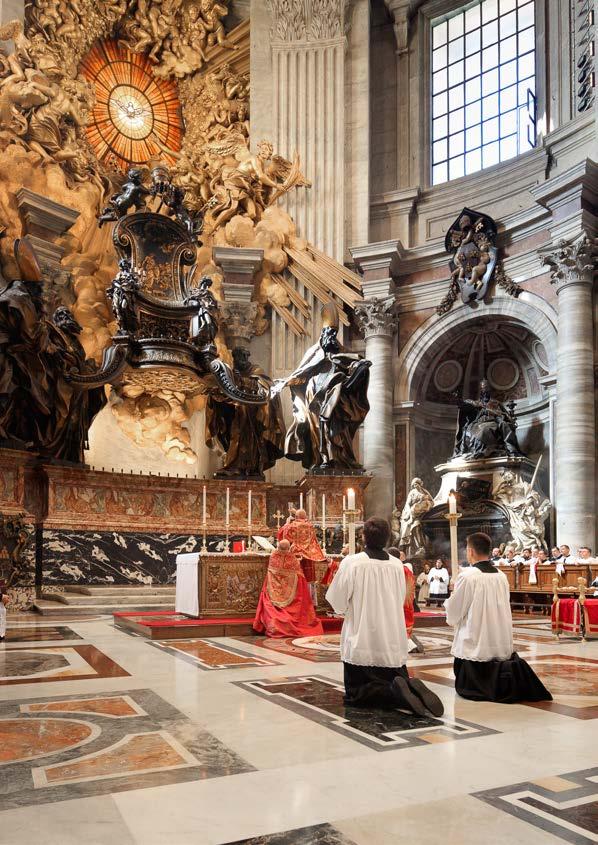
THE TRADITIONAL LATIN
MASS
RETURNS TO THE VATICAN MADE HOLY TO HER NAME: The Pilgrimage of Our Lady of Christendom


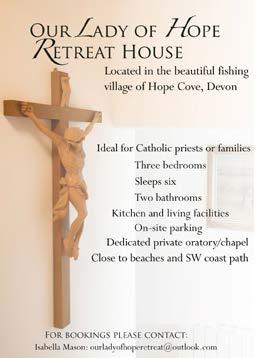
ourladyofhoperetreat.co.uk

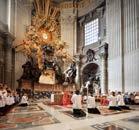



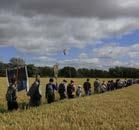
5 Chairman’s Message: A positive outcome Joseph Shaw on meetings with Pope Leo, and the principle of liturgical pluralism
6 Year planner
9 The sanctity of St Thérèse Daniel Jahansouz on why we must do ordinary things with extraordinary love
10 The Millennial Church Comes of Age Louis Maciel reports from the WeBelieve Festival
13
Obituary: Fr Patrick Hayward 1934-2025 Fr Christopher Basden remembers a uniquely sensitive man with a heart for the underdog
14 Christ upon the Waters Richard Pickett, reflects on the traditional Latin Mass’s return to the Vatican and Newman’s elevation as Doctor of the Church
16 Spirituality: The Five first Saturdays Fr Thomas Crean on ‘This little reparation…’
18 Thank you, Our Lady! Mary O’Regan on modern miracles of the Miraculous Medal
20 Architecture: Popish Elvet and the Church of St Cuthbert Paul Waddington looks at an area of Durham with a very Catholic history
23 Proclaiming Christ Do not hesitate to share your faith, says Joseph Jarvis
24 Made Holy to Her Name Christian Jenkins reports from the Pilgrimage of Our Lady of Christendom
30 A Murderer… and a Saint? Fr Rupert Allen Cong. Orat. on the life of Jacques Fesch
33 An invitation to readers… Canon Post on the ICKSP’s forthcoming Preston Open House
34 Reports from around the country What’s happening where you are
42 India’s Catholic Viceroy Charles A. Coulombe remembers George Robinson, 1st Marquess of Ripon
44 Liturgical calendar
45 World News Paul Waddington takes a look at what’s happening around the globe
46 Crossword
22 Pilgrim’s ale Sebastian Morello on the joys of Greene King’s Olde Trip
27 Family matters All Sacraments are an outward sign and symbol of an inward grace, but The Cross goes further, as James Preece explains
28 Art and devotion Caroline Farey on the Signaculum Domini and the Monreith Cross

MASS OF AGES MAGAZINE
Editor: Tom Quinn, editor@lms.org.uk
Design: GADS Ltd. & Selina Fang
Printers: Vyner Print Media Ltd.
Due to the considerable volume of emails and letters received at Mass of Ages, it is regrettably not always possible to reply to all correspondents.
DISCLAIMER: Please note that the views expressed in this publication are not necessarily those of the Latin Mass Society or the Editorial Board. Great care is taken to credit photographs and seek permission before publishing, though this is not always possible. If you have a query regarding copyright, please contact the Editor. No part of this magazine may be reproduced without written permission.
THE LATIN MASS SOCIETY
FOUNDED 1965
PATRONS
Sir Adrian Fitzgerald, Bt The Rt Hon Lord Gill The Rt Hon Sir Edward Leigh, MP
Sir James Macmillan, CBE . The Lord Moore of Etchingham Prof. Thomas Pink . John Smeaton
LOCAL REPRESENTATIVES
COMMITTEE
CHAIRMAN:
Dr Joseph Shaw
SECRETARY: David Forster
TREASURER: Sarah Ward
HONORARY OFFICERS:
Alastair Tocher
Paul Waddington
OTHER COMMITTEE MEMBERS:
Selina Fang, Julia Jones, Kevin Jones, Antonia Robinson, Aileen Seymour
NATIONAL CHAPLAIN:
Mgr Gordon Reid
STAFF AND FREELANCERS
GENERAL MANAGER: Richard Pickett, richard@lms.org.uk
FINANCIAL ADMINISTRATOR: Gareth Copping, gareth@lms.org.uk
OFFICE ASSISTANT: Mauricio Rodriguezs, info@lms.org.uk
ADMINISTRATION OFFICER: Hamish Rogers, hamish@lms.org.uk
EDITOR, MASS OF AGES: Tom Quinn, editor@lms.org.uk
COMMUNICATIONS OFFICER: Daniel Beurthe, daniel@lms.org.uk
CREATIVE CONTENT PRODUCER: Clive Watson, clive@lms.org.uk
LONDON DIRECTOR OF MUSIC: Dominic Bevan, southwell@lms.org.uk
VOLUNTARY ROLES
SAFEGUARDING: David Forster, safeguarding@lms.org.uk
GUILD OF ST CLARE: Lucy Shaw, guildofstclare@lms.org.uk
GREGORIAN CHANT NETWORK: Alastair Tocher, chant@lms.org.uk
SOCIETY OF ST TARCISIUS: Dr Joseph Shaw, tarcisius@lms.org.uk
EDITOR, LMS ORDO: Peter Day-Milne, ordo@lms.org.uk
ARUNDEL & BRIGHTON: Dr Emma-Louise Jay, arundel@lms.org.uk
BIRMINGHAM (City & Black Country) : Louis Maciel, birmingham@lms.org.uk
BIRMINGHAM (North Staffordshire) : Alan Frost, staffs@lms.org.uk
BIRMINGHAM (Oxford) : Dr Joseph Shaw, oxford@lms.org.uk
BIRMINGHAM (Warwickshire) : John Bradley, warwickshire@lms.org.uk
BIRMINGHAM (Worcestershire) : Alastair Tocher, malvern@lms.org.uk
BRENTWOOD (East) : Alan Gardner, brentwoodeast@lms.org.uk
BRENTWOOD (London) : Mark Johnson, brentwood@lms.org.uk
CARDIFF-MENEVIA (Cardiff) : Andrew Butcher, cardiff@lms.org.uk
CARDIFF-MENEVIA (Herefordshire) : Shaun Bennett, herefordshire@lms.org.uk
CARDIFF-MENEVIA ( Ledbury) : Alastair Tocher, malvern@lms.org.uk
CARDIFF-MENEVIA ( Menevia) : Tom & Elaine Sharpling, menevia@lms.org.uk
CLIFTON: James and Mari Carmen Osborn, clifton@lms.org.uk
EAST ANGLIA ( Walsingham) : Tom Fitzpatrick, walsingham@lms.org.uk
EAST ANGLIA (West) : Gregor & Alisa Dick, cambridge@lms.org.uk
EAST ANGLIA ( Withermarsh Green) : Sarah Ward, withermarshgreen@lms.org.uk
HEXHAM & NEWCASTLE: John Fagan, hexham@lms.org.uk
LANCASTER: John Rogan, lancaster@lms.org.uk
LANCASTER (Cumbria) : Nicholas Steven, warwickbridge@lms.org.uk
LIVERPOOL: Andrew Doyle, liverpool@lms.org.uk
LIVERPOOL (Warrington) : Alan Frost, warrington@lms.org.uk
MIDDLESBROUGH: Paul Waddington, middlesbrough@lms.org.uk
NORTHAMPTON (South) : Barbara Kay, bedford@lms.org.uk
NOTTINGHAM: Jeremy Boot, nottingham@lms.org.uk
NOTTINGHAM (South) : Paul Beardsmore, northampton@lms.org.uk
PLYMOUTH (Cornwall) : Stefano Mazzeo, cornwall@lms.org.uk
PLYMOUTH (Devon) : Patrick Oliver, devon@lms.org.uk
PLYMOUTH (Dorset) : Maurice Quinn, dorset@lms.org.uk
PORTSMOUTH: Carol Turner, portsmouth@lms.org,uk
PORTSMOUTH (Isle of Wight) : Peter Clarke, iow@lms.org.uk
SALFORD: Alison Fraser-Kudlowski, salford@lms.org.uk
SHREWSBURY (Cathedral) : Victoria Keens, shrewsbury@lms.org.uk
SHREWSBURY (Wirral) : Kevin Jones, wirral@lms.org.uk
SOUTHWARK (Chislehurst) : Christopher Richardson, chislehurst@lms.org.uk
SOUTHWARK (Clapham Park) : Thomas Windsor, claphampark@lms.org.uk
SOUTHWARK (Kent) : Marygold Turner, kent@lms.org.uk
SOUTHWARK (Thanet) : Dr Christopher Serpell, thanet@lms.org.uk
SOUTHWARK (Wandsworth) : Julia Ashenden, wandsworth@lms.org.uk
WESTMINSTER (Hertfordshire): Tom Short, herts@lms.org.uk
WESTMINSTER (Warwick Street): Nicolas Ollivant, warwickstreet@lms.org.uk
WESTMINSTER (Willesden) : Mauricio Rodriguez, willesden@lms.org.uk
A positive outcome
Joseph Shaw on meetings with Pope Leo, and the principle of liturgical pluralism
We have all been waiting for Pope Leo to reveal something about his attitude to the Traditional Mass, and I write after two indications, coming in quite quick succession. By the time readers see this there may have been more, but these retain a special value precisely because they are the first ones.
The first one we heard about was Pope Leo’s reception of Cardinal Raymond Burke, which was followed by the announcement that His Eminence would celebrate Mass for the annual Ad Petri Sedem pilgrimage on 25 October, in St Peter’s. This followed two years in which this pilgrimage of Catholics attached to the Traditional Mass has not been allowed Mass in St Peter’s, although we were allowed in for other devotions. (I say ‘we’ because the Latin Mass Society is a member of the organising group, alongside many other traditionalist organisations.)
We don’t have an account of what Pope Leo said in this meeting, but this is clearly a very positive outcome.
Shortly afterwards, the American news agency Crux published a series of articles containing extracts from some long interviews they conducted with the Holy Father, on a wide range of topics, as advance publicity for their publication as a book. The Crux team, led by the veteran Vatican journalist John Allen, asked about the Traditional Mass among other things, and Pope Leo replied that he hadn’t had a chance to ‘sit down with a group of people who are advocating for the Tridentine rite’.
Allen’s interviews took place before Pope Leo’s audience with Cardinal Burke, when he did after all have the chance to sit down with a supporter of this liturgy. We could not have wished for a more distinguished, principled, or balanced advocate of the ancient Mass than His Eminence, and the result was
What harm will it do, to allow future generations to see in its fullness the Mass that inspired countless generations of martyrs, scholars, and popes?
very positive. We will see if Pope Leo wants to talk to more traditionalists, whom he chooses, and what he makes of them.
Pope Leo further observed to Allen that, ‘the, say, “abuse” of the liturgy from what we call the Vatican II Mass, was not helpful for people who were looking for a deeper experience of prayer, of contact with the mystery of faith that they seemed to find in the celebration of the Tridentine Mass’.
He also referred to polarisation on this question, and the intransigent nature of traditionalist supporters: he says that bishops have told him, ‘“we invited them to this and that and they just won’t even hear it”. They don’t even want to talk about it.’
I wonder if the ‘this and that’ being offered were things like the Novus Ordo in Latin. This would connect it with the Holy Father’s earlier remarks about liturgical abuses. Certainly, if you think that all Traditional Catholics really

need is a more reverent celebration of the Novus Ordo, it will inevitably be disappointing if offers of a more reverent Novus Ordo do not satisfy them. But we really need more context to make sense of these remarks: perhaps it will be supplied by John Allen’s book, when it is published next year.
The fact is, Traditional Catholics are intransigent, in the sense that we don’t want to accept less than the Traditional Mass in its integrity.
G.K. Chesterton said somewhere that we can be broadminded because our predecessors were narrow-minded: only by keeping the ancient Mass whole and entire (though it must be said that even this phrase admits of some interpretation) will our successors be able to choose between it and the post-Vatican II options.
And why shouldn’t they have that option? What harm will it do, to allow future generations to see in its fullness the Mass that inspired countless generations of martyrs, scholars, and popes? The liturgical pluralism that this implies has a greater value than a coercive uniformity that destroys what Pope Benedict called a ‘treasure’ for the Church.
The current situation could not have been foreseen, but the principle of liturgical pluralism was championed by the Second Vatican Council:
‘Even in the liturgy, the Church has no wish to impose a rigid uniformity in matters which do not implicate the faith or the good of the whole community.’ (Sacrosanctum Concilium 37)
‘Variety within the Church in no way harms its unity; rather it declares it more powerfully [eam potius declaret].’ (Orientalium Ecclesiarum 2)
To someone who takes Vatican II as the guiding light on liturgical questions, these quotations should on their own be a sufficient defence of the ancient liturgy.
YEAR PLANNER
At the time of going to press the following events are planned. For fuller details and other events see lms.org.uk

HOLY CROSS PILGRIMAGE
To mark the Jubilee Year 2025 and the LMS’ Sixtieth Anniversary a relic of the True Cross is visiting churches throughout England and Wales. To find out when the relic is in your area visit the official website: holycross2025.org . Prayer petitions can be left on the website. The relic will be present at events marked with an asterisk (*) below.
SATURDAY 25 OCTOBER
Gregorian Chant Training Day
St William of York, Reading. With Iain Simcock of the Schola Gregoriana. From 10.45 am, with Mass of Our Lady at 5:30pm. Booking at lms.org.uk/events .
FRIDAY 24- SUNDAY 26 OCTOBER
Rome Pilgrimage – Peregrinatio ad Petri Sedem
10th Pax Liturgica Gathering, Rome. en.summorum-pontificum.org
SATURDAY 25 OCTOBER
Solemn Pontifical Mass with Cardinal Raymond Burke
St Peter’s Basilica, Vatican City, 3.00 pm (Rome time).
MONDAY 3 NOVEMBER
Catholic Police Guild Annual Sung Requiem Corpus Christi, Maiden Lane, London, 6.30 pm.
MONDAY 10 NOVEMBER
Catholic Military Association Annual Sung Requiem
Corpus Christi, M aiden Lane, London, 6.30 pm.
SATURDAY 22 NOVEMBER
Society of St Tarcisius Server Training Day & Guild of St Clare Vestment Mending Day
St Dominic's Haverstock Hill (Rosary Shrine), London, 10.30 am to 4 pm. Booking for server training: lms.org.uk/ev ents
SATURDAY 22 NOVEMBER
Sung Vespers
Sung Vespers of St Cecilia, marking the 175th Anniversary of St Mary’s University, Twickenham. St Mary’s University Chapel, 4.00 pm. The service will include a selection of polyphony by English composers sung by the Southwell Consort.
LMS 60 th ANNIVERSARY CELEBRATIONS VISIT OF BISHOP MARIAN ELEGANTI

SATURDAY 1 NOVEMBER
Pontifical High Mass of All Saints
Annual Mass of reparation for abortion.
Holy Child, Bedford, noon. Followed by reception.*
SUNDAY 2 NOVEMBER
Pontifical High Mass
SS Peter and Paul, New Brighton, 10.30 am.*
MONDAY 3 NOVEMBER
Sermon at High Requiem Mass of All Souls York Oratory, 6 pm.
TUESDAY 4 NOVEMBER
Pontifical Low Mass
More House, York University Catholic Chaplaincy, 6.30pm.
WEDNESDAY 5 NOVEMBER
Pontifical Low Mass
SS Gregory and Augustine, Oxford, 6.00 pm.*
SATURDAY 8 NOVEMBER
Pontifical High Mass of Requiem, LMS Annual Requiem
Blackriars Priory, Oxford, 11.00 am.*
SATURDAY 6 DECEMBER
A Royal Spanish Advent
An Advent concert of Hispano-Flemish polyphony at St James’ Spanish Place, London. Directed by Jeremy Summerly, with soloists Ana Beard Fernandez and Dominic Bevan. southwellconsort.com
GREGORIAN CHANT TRAINING DAY Saturday 20 December, Our Lady of the Assumption, Warwick Street, London, from 9.45 am - Vespers, 5 pm. With Iain Simcock and Julia Jones. All levels of experience welcome. £10/5 book at lms.org.uk/events.
PALESTRINA 500 FESTIVAL in celebration of the Jubilee Year the Southwell Consort is holding a season of music by Palestrina and his contemporaries at Corpus Christi, Maiden Lane, London, and elsewhere. lms.org.uk/music
SPRING RESIDENTIAL LATIN COURSE 13 – 17 April 2026, Carmelite Retreat Centre, Boars Hill, Oxford.


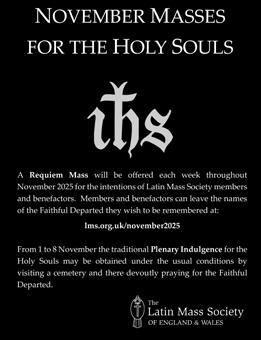
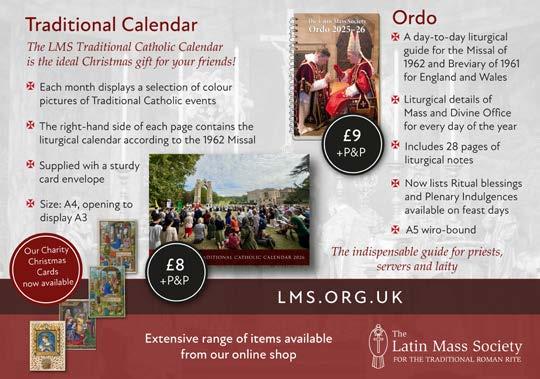
The sanctity of St Thérèse
Daniel Jahansouz on why we must do ordinary things with extraordinary love
Pope St Pius X famously called St Thérèse of Lisieux, “the greatest Saint of modern times,” a truly remarkable declaration even before her beatification process began.
What did this holy Pope see in this 24-year-old Carmelite? A recent pilgrimage to her homes in Alençon and Lisieux by a group from the FSSP parishes in Bedford and Chesham Bois, accompanied by Father Armand de Malleray, made the answer clear.
The sanctity of St Thérèse is something known worldwide, but seeing the house she was born in struck a different chord. The Alençon house was the only one where the entire Martin family lived together. It was quaint, beautifully decorated, modest, and filled with holy images of the crucifix and beautiful drawings from Céline, one of Thérèse’s sisters. Above all, the home is strikingly ordinary; there is no extravagance or lavishness. This ordinariness is the very key in understanding the greatness of the Martin family.
This theme was highlighted by Father de Malleray in a session with the teenagers on the trip. When asked for practical advice that we can apply from St Thérèse in our lives, Father quoted her: “We must do ordinary things with extraordinary love.” This simple phrase captures the essence of her Little Way (La petite voie).
This is further proven by the fact that Thérèse’s peers in Carmel said that, “she had never had to suffer and that her life had been rather insignificant”.
But this was her exact point. Her parents, Sts Louis and Zélie Martin, were ordinary people in ordinary circumstances, raising five daughters. Yet they always did it by “Serving God First,” a key phrase inscribed on a prayer card of theirs in Alençon. The holy parents lead by example, visiting the needy, sharing a strong Marian devotion, and infusing their daily
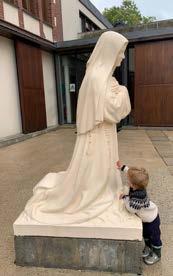
routine with acts of charity. They had a hidden sanctity lived in the domestic church of their home.
St Thérèse articulates this beautifully in her autobiography Story of a Soul (L'Histoire d'une Ame). She is puzzled why some souls seem to flourish like roses and lilies, while others, like “poor savages,” never hear God’s name. Her revelation was that the garden of souls needs its humble violets and daisies just as much as its brilliant flowers. She writes, “Perfection consists in doing His will, in being what He wills us to be”. The splendor of the rose does not rob the violet of its perfume, and to wish otherwise would strip the springtime field of its beauty. Our lowliness is not for abasement, but for humility, a sign of genuine virtue, which St Francis de Sales writes is like pure balm that falls to the bottom when distilled.
This sanctity, nurtured in Alençon, blossomed in Lisieux. It was in the family home where young Thérèse was cured by a miracle of her illness through the intercession of Our Lady of the Smile. This sanctity was also fuelled by the sacraments, in particular her profound devotion to the Holy Sacrifice of the Mass. The traditional Roman Rite was integral to her, as she allowed herself to be a sacrificial offering alongside the Lord Jesus in Holy Mass.
This liturgical heritage continues today in Alençon, in which the Carmelite nuns have adopted the traditional form of the Mass, and their Mother Prioress shared that their convent is now full, a testament to its vitality. She, in addition to the other sisters, prays for God to take one of them away so they may accept more postulants. How sweet of Mother Prioress and the nuns to accept this sacrifice to admit more virgins into Carmel!
The chapel in Alençon, with its glorious marble floors and wonderful statues of the Sacred Heart and Immaculate Heart opposite each other, creates a glimpse of heaven on earth in the Alençon countryside.
It may seem daunting to replicate the holiness of St Thérèse or her parents, but their message is precisely that we are not called to replicate extraordinary deeds, but to inflame our ordinary ones with extraordinary love. The Martin family’s spirituality was hidden in their daily lives, and their charity was directed first to God, and overflowed to the rest of the world.
May this wonderful family intercede for us all, teaching us how to love Jesus Christ with all our hearts (de tout mon coeur), as their little Thérèse so loved to say.
A young pilgrim venerating the statue of St Thérèse
The Millennial Church Comes of Age
Louis Maciel reports from the WeBelieve Festival

Driving back from the WeBelieve festival, I was pondering how best to describe what I had just experienced over the previous four days. As luck would have it, a Priest friend on Facebook had beaten me to it, posting that it was “hands down” the best Catholic event he had been to, with no labels or divisions, just one united Church on fire with the Holy Spirit and ready to evangelise the United Kingdom. I reposted this commenting that it reminded me of the church under Pope Benedict.
Over the weekend and in the days that followed, a string of photos and videos, often by Sancta Familia, whose coverage of the Festival was outstanding, dominated my newsfeed: a glimpse of the Ukrainian Liturgy, drone footage of the festival, a modern worship song being sung during confession – but what really set social media alight were the pictures of the
High Mass that took place in the packed Pugin chapel of Oscott College at Sunday lunchtime.
It is difficult to describe how cathartic this image was to those attached to the liturgy antecedent to 1970: after years during which traditional Masses had been ended, permissions of longstanding Masses denied and priests moved on, here was a Traditional Mass unashamedly being celebrated in the historic chapel of one of our two remaining on-shore seminaries.
I suggested to a seminary employee that this image should be plastered all over the seminary’s vocational literature to stem the migration of diocesan vocations to the former Ecclesia Dei communities following the restrictions placed on newly ordained priests by Traditionis Custodes.
Several Bishops and three Archbishops were in attendance at the festival, including Archbishop John Wilson of
Southwark, who celebrated the thirtieth anniversary of his ordination that weekend, Archbishop Mark O’Toole of Cardiff-Menevia and Birmingham’s own Archbishop Bernard Longley. Earlier that month, Archbishop Bernard had been appointed to serve as a member of both the Dicastery for Promoting Christian Unity and the Dicastery for Interreligious Dialogue. This seemed quite apt: it is not possible to achieve reconciliation among Christians or with those who do not yet recognise Christ without an internal reconciliation occurring first of all within the church.
In a church in which the previous generation had appeared relaxed with moral ambiguity while demanding a liturgical conformity to the spirit of the council, this festival was the reverse: a celebration of liturgical diversity united under the fullness of the faith. It appears to be a generational shift.
© Sancta
Familia
The Big Tent
WeBelieve was organised by the Guild of Our Lady of Ransom in association with Oscott College to celebrate the 175th anniversary of the restoration of the Catholic hierarchy in England and Wales, the 1700th anniversary of the Nicene Creed, and start an Octave of prayer looking towards the Great Jubilee of Redemption in 2033, taking place under the backdrop of the ‘quiet revival’ of Christianity reportedly happening among Generation Z.
It was literally big tent Catholicism: for those of us old enough to be young enough to remember, prior to the pandemic, Youth 2000 held a festival over the August Bank Holiday weekend in Walsingham, the centrepiece of which was a large marquee in which the main liturgies took place. The organisation was founded in 1990 by a young Englishman named Ernest Williams, inspired by Pope John Paul II’s call to young people at World Youth Day 1989. It is authentically Catholic, although perhaps a bit modern for the tastes of regular readers, being run by young people for young people and founded to prepare the church for the new Millenium, hence the Michael Apted-esque name.
The influence of Youth 2000 was recognisable in several features of WeBelieve, with the organisers having worked on the Walsingham festival in the past: in addition to the big tent, the campsite and several smaller tents called Truth, Beauty, Goodness and Family where the workshops took place, there was a healing service, all night adoration and the presence and testimony of former London gangster John Pridmore.
In its latter years, the festival at Walsingham coincided with the arrival of the LMS Walking Pilgrimage at the Shrine, when at 3pm on Sunday High Mass would be celebrated. Many of the attendees at Youth 2000 would leave the afternoon workshops to attend the Extraordinary Form Mass in the Shrine. Who would have thought that young people would be so attracted to tradition?
The main departures of WeBelieve from Youth 2000 was the liturgical diversity rather than focus on modern worship, the lack of an age limit, and its location in Birmingham rather than Walsingham. As well as being much easier to get to, Birmingham was a natural fit for the festival, with St John Henry Newman delivering his famous Second Spring Sermon in the Pugin Chapel following the restoration of the hierarchy; one of the reasons Pope

Benedict visited the seminary during his State Visit in 2010.
The vocational fruits of the Benedict Bounce were visible at the festival fifteen years on: former alumni Fr Pascal Uche of Brentwood Diocese, who as a young layman memorably welcomed Pope Benedict to Westminster Cathedral; Fr Frankie Mulgrew, a former stand-up comedian who is the son of ’80s Irish comedian Jimmy Cricket; and Fr Ryan Service, who, while not an alumnus, felt personally called to his vocation at Cofton Park when the Pope quoted Newman with the following words: “Our divine Master has assigned a specific task to each one of us, a ‘definite service’, committed uniquely to every single person: ‘I have my mission’, he wrote, ‘I am a link in a chain, a bond of connexion between persons’.”
Also in attendance were the former Rector of Oscott, Bishop David Oakley of Northampton, and the auxiliary Bishop of Birmingham Timothy Menezes, who along with Bishop Patrick McKinney of Nottingham all hail from the same parish of St Dunstan’s in south Birmingham. Not bad for a church rejected by JRR Tolkien’s mother in favour of the Oratory.
Highlights of the festival included a talk by St Gianna Molla’s daughter, technically a living second class relic, who was able to give her testimony because her mother refused an abortion. The Truth tent was dominated by the Dominicans, with several friends of the LMS delivering workshops in the Beauty tent, including Sir James McMillan, Fr Armand de Malleray and
Dr Matthew Ward. Habited sisters from the Dominican Sisters of St Joseph, the Sisters of Mary Morning Star and the Benedictines of Mary, newly invited to Colwich, peppered the festival in stark contrast to the Thatcherite power suits that were the apparent apparel of choice for sisters of a previous generation.
A few days after this festival, the Vatican announced St John Henry Cardinal Newman would be declared a Doctor of the Church, with Archbishop Longley suggesting he should have the title Doctor Amicabilis in one of the workshops. When he died, fifteen thousand Brummies lined the streets to pay their respects as his coffin went past. The day before the announcement, they did the same for Ozzy Osbourne. Like the world, the Catholic Church is going through changes, but with Millennials at the forefront, tradition will be firmly part of the future.

It was often remarked under the previous Pontiff that it takes around one hundred years for the fruits of a council to become apparent, often in an attempt to justify the suppression of the traditional liturgies. However, perhaps the truth is the opposite of what is being argued: once the initial zeal of an ecumenical council wears off, a more reasoned and nuanced approach is taken which sets the legacy of the council. A new generation has taken up the mantle of announcing the Gospel of Jesus Christ in the postVatican II church. The Millennial Church has come of age.
© Sancta Familia
Packed Latin Mass
© Sancta Familia
The Mass

Fr Patrick Hayward 1934-2025
Fr Christopher Basden remembers a uniquely sensitive man with a heart for the underdog
Patrick Hayward was born an orphan in 1934, and was brought up by the Sisters of Mercy in Bodmin, Cornwall. At that time all the parishes in that county were run from the Abbey of the Canons Regular of the Lateran in Bodmin, so he continued his education with them in their school in Datchet near Windsor.
Entering their noviciate back in Bodmin he was then sent to Rome, where he studied at the Gregorian University and was ordained in 1959. Returning to the Abbey in Bodmin he taught philosophy and did parish work there and in Eltham where the Canons run the parish to this day.
In 1969 he was involved in a traumatic road accident and was seriously concussed. His personality was transformed; he lost all his self-confidence and retreated into anonymity. He found refuge in a squat with alcoholics and drug addicts, who accepted him as he accepted them.
In 1977, in Ashford, Kent (while fruit picking with fellow homeless men) he met Sister Imelda (Kathleen) Hennecker, a Daughter of Jesus of Kermaria. She recognised Fr Patrick's unique qualities, and over the years encouraged him to return to the practice of his priesthood.
He had missed the tumultuous 1970s and discovered that the Traditional Rite seemed gone forever. He missed it very much, as he told me in 1980 when I was just ordained and assigned to Ashford. Sister Imelda restored his confidence and he began saying Mass again with her sister and brother-in-law (Bill and Nora Batt) at St John the Baptist in Purley.
Sister was inspired by Fr Hayward's remarkable intelligence and grounding in the spiritual classics. He inspired her to found the charity Ashford Action for the Single Homeless.
Fr Hayward soon found his niche in celebrating the Traditional Rite, and gradually under Pope John Paul II, as the indult allowing this grew, he found his great apostolate in offering the Monday

night Mass at Corpus Christi Maiden Lane. He was a familiar figure at Latin Mass Society events, often functioning as one of the Sacred Ministers at High Masses and the Sacred Triduum. He also supplied for the Bon Secours sisters and in the end was living near the Dominicans of Haverstock Hill, until he fell into the cloud of Alzheimer’s.
Fr Hayward was a uniquely sensitive man with a heart for the underdog. All who met him experienced his depth of goodness, and genuine holiness. He was born an orphan and spent much of his life, like St Benedict Joseph Labre,
among the displaced, the homeless, and addicts. He had an innate recognition of the Church's huge loss of her Tradition and common sense with the tragic collapse of religious life and the priesthood in the past few decades.
Rising above the blindness of so many churchmen to the loss of the Mass of Ages he contributed to the rediscovery of the Traditional Mass for so many souls. He has helped us in England to restore the faith and secure a future for Catholicism despite the chaos and decline all around us!
May he be rewarded and find his place in the Eternal Sanctus on High!
Fr Hayward assisting as Sub Deacon at Pontifical Mass inWestminster Cathedral in 2015, on the occasion of the Latin Mass Society's AGM
© Joseph Shaw
Christ upon the Waters
LMS General Manager, Richard Pickett, reflects on the traditional Latin Mass’s return to the Vatican and Newman’s elevation as Doctor of the Church
The Vatican’s St Peter’s Basilica is no stranger to moments that bear the weight of history. As Joseph Shaw reports elsewhere in this magazine, 25 October 2025 will witness the traditional Roman Rite restored to a place of honour within the basilica. After Traditionis Custodes, the usus antiquior had been confined to occasional celebrations of Low Mass in the crypt, but Pope Leo has now granted permission for Cardinal Raymond Burke to celebrate a Solemn Pontifical Mass at the Altar of the Chair, as part of the annual Summorum Pontificum Pilgrimage.
Just one week later, on All Saints’ Day, the Holy Father will preside at a Vatican Mass, during which he will proclaim St John Henry Newman a Doctor of the Universal Church. Newman will join that select company of just 37 other Doctors – among them only one other Englishman, St Bede the Venerable –thus recognised for their holiness and the eminence of their teaching.
The convergence of these two events reminded me of St John Henry’s sermon Christ upon the Waters, preached at the Consecration of Bishop William Ullathorne. Newman used that moment – marking the Restoration of the Catholic Hierarchy 175 years ago – to reflect on the revival of English Catholicism, which elsewhere he called the “Second Spring”:
“The Church is coming out of prison as collected in her teaching, as precise in her action, as when she went into it. She comes out with pallium, and cope, and chasuble, and stole, and wonder-working relics, and holy images … What an awful vitality is here! What a heavenly sustained sovereignty! What a selfevident divinity!”
The return of the church’s ancient Liturgy in its full solemnity to the heart of the Vatican is not, of course,

the journey’s end. Traditionis Custodes remains in force, and while Pope Leo has signalled an openness to dialogue concerning the usus antiquior, the voyage ahead remains uncertain. We will continue, with patience and perseverance, to make the case for the Mass of our forefathers.
Upon the election of Pope Leo, the Latin Mass Society invited its members and supporters to contribute to a spiritual bouquet of intercession and good works for the new Pontiff. Over 5,000 pledges, including 3,000 Rosaries, were received, and Cardinal
Burke delivered the bouquet to the Pope personally. We must sustain that offering of prayer for the Holy Father and his Petrine ministry, desiring for him wisdom, courage, and fidelity in shepherding the Church.
In the words of Newman, whose faith in Christ shines so brilliantly in his writings:
“Let us not despair if we see the rock against which we shall break – the wave may be high, and the tempest loud, but the sea is the Lord's, and He can calm it when He pleases.”
Christ on the waters by Ivan Aivazovsky

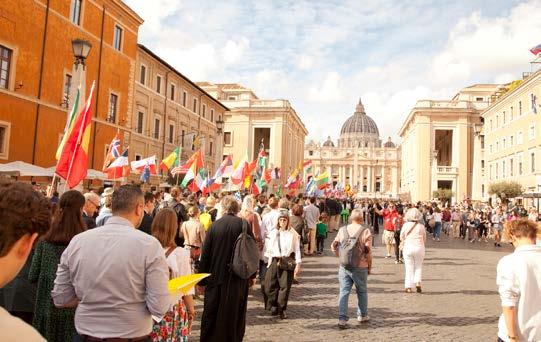
The 2023 Summorum Pontificum Pilgrimage at the Vatican
© Joseph Shaw
The Five first Saturdays
Fr Thomas Crean on
‘This little reparation…’
Although the deposit of faith was closed with the death of the last apostle, heaven has not fallen silent since then. “At all times”, writes St Thomas Aquinas, “there have not been lacking persons having the spirit of prophecy, not indeed for the declaration of any new doctrine of faith, but for the direction of human acts”.
Sr Lucia dos Santos was the prophetess whom God chose to remain on earth for ‘a little while’, that is, for eighty-eight years, after the stupendous miracle of Fatima, in order to make better known the words that our Lady spoke in Portugal in 1917. It is through Sr Lucia’s testimony that we know of the ‘five first Saturdays’, and of heaven’s invitation to practise them.
The devotion was not entirely new. Pope Leo XIII, in 1889, had granted an indulgence to the faithful who would go to confession and Holy Communion for fifteen consecutive Saturdays in honour of the Blessed Virgin. St Pius X, on June 13 1912, had indulgenced the practice of making reparation for offences against our Lady on, specifically, the first Saturday of the month. It was exactly five years later, on 13 June 1917, that the future Sr Lucia, along with her cousins St Francisco and St Jacinta, saw a vision of Mary with her heart surrounded by thorns that seemed to pierce it through. At the same time, she heard our Lady say: “My Immaculate Heart will be your refuge, and the way that will lead you to God.”
On the following apparition, that of 13 July 1917, the three children received the famous vision of hell. Then they heard Mary say to them kindly: “You have seen hell, where the souls of poor sinners go. To save them, God wishes to establish in the world devotion to My Immaculate Heart.” Then she promised that at some future time, she would come to ask for the consecration of Russia, and for a ‘communion of reparation’ on the first Saturdays.
Eight years passed. Saints Franciso and Jacinta had completed their short and heroic lives and gone to heaven, leaving their cousin on earth. Lucia had just entered the convent of the Dorothean sisters in Pontevedra, in Spain. On Thursday 10 December 1925 she was in her cell after supper. There she tells us that she experienced a vision of our Lady and the Christ child. She would describe it later, speaking of herself in the third person:
The Blessed Virgin appeared to her, and by her side, raised on a bright cloud, was the child Jesus. The Blessed Virgin rested her hand on her [Lucia’s] shoulder, and as she did so, showed her a heart encircled by thorns, which she was holding in her other hand.
The Child said: ‘Have compassion on the Heart of your most holy Mother, covered with thorns, with which ungrateful men pierce It at every moment, and there is no one to make an act of reparation to remove them.’
Having heard Jesus speak of this evil, Lucia then heard His mother speak of the remedy:
The most holy Virgin said: ‘Look my daughter, at my Heart, surrounded with thorns with which ungrateful men pierce me at every moment by their blasphemies and ingratitude. You at least try to console me and announce in my name that I promise to assist at the moment of death, with all the graces necessary for salvation, all those who, on the first Saturday of five consecutive months, shall confess, receive Holy Communion, recite five decades of the rosary, and keep me company for fifteen minutes while meditating on the fifteen mysteries of the rosary, with the intention of making reparation to me.
Lucia told the superior of the convent, Mother Magalhaes, what had happened. Alluding discreetly to
the event in the postscript of a letter written to the local bishop not long after, this superior would relate:
Maria das Dores [that is, Lucia] … told me that she had received a great grace from the Most Holy Virgin here, and I don’t doubt it because the child possesses virtue and simplicity in such great abundance that she must even charm the Most Holy Virgin! In these matters I am the most sceptical person you could find in the world, but in her case I absolutely don’t doubt it. 1 In fact, however, there have not been wanting people even more sceptical than Mother Magalhaes. Granted, they say, that heaven might encourage us in a general way to make reparation for sin, why would God reveal such a complicated devotion? And why five Saturdays, not four, say, or ten?
These objections are not very weighty. Chesterton remarked that a key might seem like an unnecessarily complicated shape to a person seeing one for the first time, but that it has the great advantage of being able to open a door. In a similar way, it does not take great faith to believe that God knows better than us what practices are most suitable for making reparation to the Blessed Virgin.
As for numbers, Scripture itself tells us that God loves them. We read in the book of Wisdom: Thou hast ordered all things in measure, and number, and weight. And the number five is divinely associated with reparation and with averting evils from the world. The paschal lamb was to be set aside five days before it was slain (Ex. 12:3-6); when this type was fulfilled on the Cross, five Wounds were made in our Lord’s body; when it is renewed in the Roman Mass, the priest traditionally makes five signs of the Cross both before and after the consecration. Since Mary associates
1. Quoted in Frère Michel de la Sainte Trinité, The Whole Truth about Fatima, vol. 2, ch. XII, appendix II.

herself so closely with her Son, it is not surprising if she requests five days of reparation.
But we have an even better explanation of why this number would be given us. A few years after the apparition at Pontevedra, Sr Lucia, having now taken her vows as a nun, was living in a nearby convent, in the town of Tuy. Her confessor, a Fr Gonçalves, had asked her this very question: why did God wish for five Saturdays of reparation, rather than nine, or seven in honour of Mary’s seven sorrows? Praying in the chapel between 11pm and midnight, on Thursday 29 May, 1930, Sr Lucia was asking for insight into the matter. She described what happened in these words:
I suddenly felt myself more intimately possessed by the divine presence and, if I am not mistaken, this is what was revealed to me: ‘My daughter, the reason is simple. There are five types of offences and blasphemies committed against the Immaculate Heart of Mary: blasphemies against the Immaculate Conception; blasphemies against her Virginity; blasphemies against her divine maternity, in refusing at the same time to recognize her as the mother of men; the blasphemies of those who publicly seek to sow in the hearts of children indifference or scorn, or even hatred of this Immaculate Mother; and the offences of those who outrage her directly in her holy images.
Sr Lucia then heard Jesus say to her: “See, My daughter, the motive for which the Immaculate Heart of Mary inspired Me to ask for this little reparation, and so to move My mercy to pardon souls who have had the misfortune of offending her.”
It’s easy to see why it should be called a ‘little reparation’. No fasting or hair-shirts required! And yet its very littleness probably leads people to stumble at it. Like the Syrian general Naaman, told by the prophet Elisha to free himself of leprosy just by bathing in the River Jordan, we are reluctant to believe that something so simple can do much good. “Are not the Abana, and the Pharphar, rivers of Damascus, better than all the waters of Israel, that I may wash in them, and be made clean?”, he said angrily, until the wiser counsels of his servants prevailed. God was testing him, to see if he would believe that divine power can make use of whatever instruments it pleases to achieve its effects.
Sr Lucia, at any rate, had no doubt of the value of this little reparation. Writing to Fr José Aparicio, formerly superior of the Jesuit community in Tuy and afterwards a novice master, she declared: “Your Reverence cannot imagine how great is my joy in thinking of the consolation which the Holy Hearts of Jesus and Mary will receive through this lovable devotion, and the great number of souls who will be saved through this.” Fr Aparicio became one of the earliest promoters of the practice.
Incidentally, in an undated letter, Sr Lucia would explain her own way of following what is probably the least well observed part of the devotion, namely meditation in company with the Blessed Virgin for fifteen minutes (note that this is something distinct from the recitation of the rosary itself.) She says that she likes to take one mystery each first Saturday, and think about that; so that it took her fifteen months to go through them all.
As we approach the centenary of the revelations of Pontevedra, I suggest that we should seriously consider the practice of the first Saturdays, if we’re not already doing so. Are things going so well in the world at the moment, that we can afford to neglect it?
The Five First Saturdays Devotion
Our Lady of the Rosary appeared to the saintly children of Fatima in 1917. It is often forgotten that Our Lady continued to speak to Sr Lucia of Fatima a few more times, and in 1925 the Blessed Virgin specifically asked that on the first Saturdays of the month, we should:
• Make a good confession in a spirit of reparation for blasphemies against Our Lady’s Immaculate Heart;
• Receive Holy Communion in a state of grace, and as an act of reparation for sins against Our Lady’s Immaculate Heart;
• Pray five decades of the Rosary;
• Meditate for fifteen minutes on the Mysteries of the Rosary.
“To all those who, on the First Saturday of five consecutive months … fulfil all the conditions requested, I promise to assist them at the hour of death with all the graces necessary for the salvation of their soul”
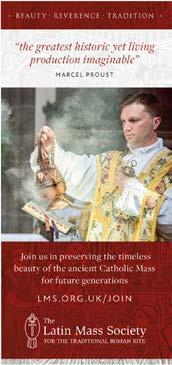
Lucia dos Santos was the prophetess whom God chose to remain on earth for ‘ a little while’
Thank you, Our Lady!
Mary
O’Regan on modern miracles of the Miraculous Medal
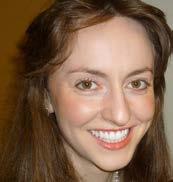
Afew years ago, I decided firmly to embrace wearing Our Lady’s Miraculous Medal every day. I’d been given a large oval one as a birthday gift from a friend and felt a calling to keep it on me. This meant that my other necklaces were put to one side. I’ve always had something of a small obsession with neck jewellery. I broke school rules by my strands of many beads and I wore a choker with feathers as a twenty something. Okay, sometimes now I wear both a fashion necklace and Miraculous Medal, but I always keep the latter dangling right over my heart.
I lacked faith in Our Lady’s incomparable intercessory powers until I escaped being mugged. I was in a smart area, going about my business, when a petite woman approached me, seemingly all smiles and friendly. But then she viciously lunged in and grabbed my Miraculous Medal, but as soon as it touched her fingers, she had to drop it like a redhot poker. I made my escape. Oh, thank you, Our Lady!
A couple I know run an ethnic restaurant that I go to often, and once a young married couple who were
there came across, and asked about my medal. They pointed and said, “Oh we recognize that as Mary”. Then they explained they were thinking of becoming Catholics. They were from a devout Presbyterian background. We got chatting. A year on, we have become the best of friends and they are Catholics.
The most science-defying miracle for me occurred when a friend’s wife was dying young and had a dire complication that not all the money or medical expertise in the world could overcome. They were nonChristians and in desperation asked me if I had any ideas. I told them give her a blessed Miraculous Medal. They did so and she recovered.
In tandem, there have been many, many occasions when lapsed Catholics have asked me why I wear my medal; sometimes they are random strangers who strike up a conversation when I’m shopping, or sometimes friends of friends. I look them straight in the eye and say I’d never be without it.
It is very timely that we gather all the little and big miracles; we have only five years until we will be celebrating the 200-year anniversary of the glorious time Our Lady gave the Miraculous Medal to humanity. Our Lady gave this gift to a 24-yearold novice. Catherine Laboure had joined the Sisters of Charity in the inner city of Paris and her usual job was in the laundry, her bare hands scrubbing linen in a tub. Then, late at night she was awoken by a tiny boy and led to the chapel which was saturated in bright light. She was met with an appearance of Our Lady who was beautiful beyond compare. This alone was an answered prophecy for the young nun who had lost her own mother at a young age and had been promised by St Vincent de Paul that she’d see the Mother of God.
Our Lady drew her close and told her that she was going to be given a “special mission” which would be revealed on 27 November 1830. On this day, when Catherine was in the chapel, Our Lady appeared with rays of light coming from her hands and through a series of visions, gave Catherine a precise portrait of a medal she wanted to be struck, with the most edifying promise: “Those who wear it when it is properly blessed will be the recipients of great graces.”
Catherine confided in her spiritual director who thought the young nun was gullibly imagining it all. Her next visit with him left him wondering had he disappointed the Mother of God. Catherine told him that in a subsequent apparition Our Lady had spoken of her grave disappointment. This spurred the priest to ask the opinion of the Archbishop, who also thought the laundress had a vivid imagination. But he was taken with the design of the medal and became convinced she was genuine. So, he had the medal stamped, and it went through several versions until it met with Our Lady’s approval. Soon the medal became internationally beloved and hailed as “miraculous” a conductor of extraordinary grace.
None of the other nuns who were with Catherine knew she had played any part in all this. All the while Our Lady appeared to her, she kept her post at the sink and scrubbed linen with a washboard and soap. While the medal was gaining such popularity, she was moved to work at a hospice, where she took on the humblest tasks; even cleaning out the stables. Catherine never shirked the dirtiest garments as laundress, and Our Lady will help the foulest sinner with cleansing grace.
A very happy feast of the Miraculous Medal on 27 November!
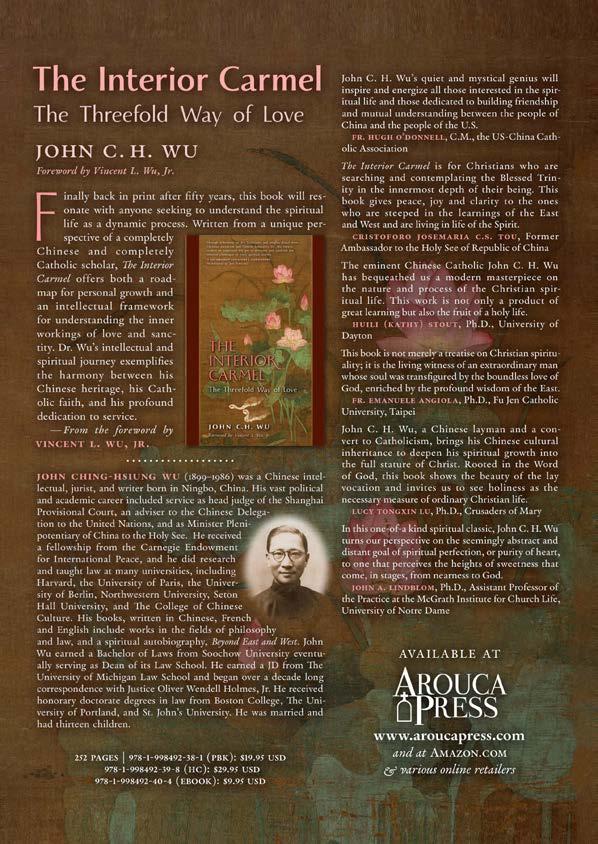
Popish Elvet and the Church of St Cuthbert
Paul Waddington looks at an area of Durham with a very Catholic history
Resistance to the Reformation was strongest in the northern counties of England. The Pilgrimage of Grace of 1536 drew its support from these northern counties, as did the Northern Rebellion of 1539, which was led by the Earls of Northumberland and Westmorland. The subsequent persecution of Catholics tended to drive them into enclaves, usually under the protection of a prominent family, and often with a priest living in secret among them.
Usually, these Catholic enclaves were in remote rural areas where life was quieter and less likely to be disturbed by unsympathetic neighbours, but there were also urban examples. One such example was the area around the street named Old Elvet in the City of Durham, which, in the seventeenth century, became known as Popish Elvet, due to the number of Catholics who settled there.
Catholic families described as “belonging to the gentry” settled in this area, and it is known that a priest was living in Old Elvet from the late 1650s. It is also recorded that a Catholic chapel was destroyed by a mob at the time of the “Glorious Revolution” of 1688. The Jesuits established a separate mission at a different address in Old Elvet and the two congregations seem to have prospered alongside one another.
As tolerance of Catholicism increased during the eighteenth century, Catholic tradespeople and craftsmen moved into the area, swelling the population. From 1795 to 1821 the Vicar Apostolic of the Northern District, Bishop William Gibson, lived at the Elvet Mission, as did his auxiliary and successor, Thomas Smith. The name, Popish Elvet, was well justified by this time.
Eventually, it was decided that the two congregations should merge, and that a new church should be built that

would be served by the secular priests. This was to be the Church of St Cuthbert, which opened, along with its attached presbytery, in 1827, just before full Catholic emancipation.
Ignatius Bonomi
The architect chosen to design the new church was Ignatius Bonomi. Besides being an architect, Bonomi was the Surveyor of Bridges for the County of Durham and a well-respected citizen of Durham. He was the son of the Italian-born Giuseppe Bonomi, who was enticed to England by Robert Adam, for whom he worked for a while. Giuseppe Bonomi designed the original church in Spanish Place in London, as well as the Bavarian Embassy church which we now know as the Assumption in Warwick Street. Ignatius Bonomi was also the uncle of George Goldie, who was to be the architect of many Catholic churches in Britain and Ireland, including St Wilfrid’s in York.
Ignatius Bonomi had already built several public buildings in Durham, including the classically styled Assize Court and the prison, both of which were very close to the site of the future St Cuthbert’s Church. He had also done work at Durham Cathedral, and would later design the Church of St Mary in Sunderland.
For St Cuthbert’s Church, Bonomi chose a Perpendicular Gothic style, crafted from a yellow sandstone. It was rectangular in shape, having a four-bay nave with a shallow sanctuary. On the (liturgical) north side, three of the four bays had pairs of tall two light windows under hood moulds. The southern wall was blank, except for a centrally placed door. The west end was built square with the main door in the centre and a large window above.
Bonomi did not provide a tower -- it would have been illegal at the time. This was added in 1869 when Canon Edward Consitt made several
St Cuthbert’s as envisaged by Ignatius

improvements. The new three stage tower was added to the west end and eliminated the original west window. It was built of similar stone, was square in plan, and had provision to house a peel of bells. It was topped by a corbelled parapet and pyramidal roof. The ground floor of the tower became a narthex, providing a much better entrance to the church.
The interior of St Cuthbert’s Church has changed considerably. Presumably to maximise the size of congregation that could be accommodated, Bonomi had provided galleries on three sides. As part of Canon Consitt’s 1869 improvements, the north and south galleries were stripped out leaving the west gallery to serve as a choir loft. This must have made the church much brighter, as the northern gallery stretched across the insides all three windows, and would have made the interior of the church very dark.
Canon Consitt also made improvements to the sanctuary. He installed a wooden panelled reredos of unusual design, with delicate tracery crafted by a local firm. It was surmounted by a rood with figures of Our Lady and St John standing either side. These were carved in Munich. He also added a Lady Chapel which has stained glass by Barnett of Newcastle.
A new alabaster High Altar was installed by Canon William Brown around 1903. This replaced a wooden
one and allowed the church to be consecrated in 1910. The Stations of the Cross were added in 1926.
Post Vatican II reordering took place during 1973 and 1974. The altar rails were removed and the level of the
sanctuary floor raised. The alabaster altar of 1903 was reduced in size and moved forward. Although these changes were done fairly sensitively, the effect has been to diminish the impact of what was a very attractive and unusual sanctuary.
The original western gallery was given an attractive wooden balustrade following the removal of the side galleries, and benefits from additional space provided by the addition of the tower in 1869. This space now houses the organ. The church has a panelled ceiling which some say gives the interior more of a Georgian feel.
St Cuthbert’s Church is currently staffed by a priest of the Diocese of Hexham and Newcastle, although, for a while, it was in the care of the Order of Preachers. It also serves as the Chaplaincy for the University of Durham. A Low Mass is offered in the Usus Antiquior at 7.15am on Fridays, which is popular with university students.
The church with its added tower and attached presbytery contributes greatly to the ambiance of this part of the city of Durham. It is also entirely appropriate that it is located in Popish Elvet.

The view from the street
The Interior of St Cuthbert’s
Pilgrim’s ale
Sebastian Morello on the joys of Greene King’s Olde Trip
The Holy Cross Pilgrimage organised by the Latin Mass Society continues its journey throughout England and Wales. It is a marvellous initiative; my family and I were very grateful to venerate the holy relic of the True Cross following a pontifical Mass arranged by the Society, celebrated by Bishop Athanasius Schneider at Northampton Cathedral.
Of course, the Church possesses such relics of the Cross on which our salvation was secured because—if we’re to believe Geoffrey of Monmouth, the 12th century priest of Arthurian fame—a British lady travelled to the Holy Land to find the true Cross. I refer, of course, of St Helena, mother of Emperor Constantine. According to the Welsh cleric, Helena was the daughter of King Cole, ruler of Britain. Fitting, then, that Constantine, the future liberator of the Church throughout the Roman Empire, was proclaimed Emperor in 306AD whilst camping outside York.
Ever since St Helena went to those lands we call Holy in search of sacred relics, sanctified as that land was by our Lord’s personal presence, all Christian nations looked east with longing. Pilgrims continued to venture there in praise of their Lord and to atone for their sins until the rise of Islam frustrated their devotions. Hence, when the Islamic invasion of the West was turned around by Duke Godfrey of Bouillon and his knights at Constantinople in 1097, those valiant Christian warriors pushed on and founded the Kingdom of Jerusalem, freeing up the pilgrim trails once more.
The newly established kingdom was without a king, for Godfrey, when the crusaders gathered to crown him King of Jerusalem, declared, “I will not wear a crown of gold where my Lord was crowned with thorns”. More accurately, then, it was a kingdom with no king but Christ. Godfrey took the title ‘Advocate of the Holy Sepulchre’. For a while, under the crusader settlement, the pilgrim trails began again, and Christians
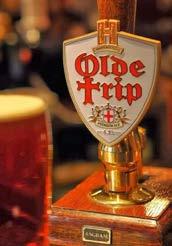
travelled in piety to the Holy Land largely without threat of robbery, enslavement, or rape from Muslim raiders.
As it happens, there is a pub in Nottingham that testifies to the devotion of English pilgrims. First opened in 1189, the pub called Ye Olde Trip to Jerusalem is now owned by the Suffolk brewery Greene King. This Inn is reputed to have been the favoured stop for knights and men-at-arms who followed King Richard the Lionheart on the Third Crusade.
Greene King Brewery has interesting connections with Catholic culture and history. It is based in Bury St Edmunds, a town named after the martyr-king of East Anglia, whose symbols of dominion and martyrdom—a crown and arrows— comprise the logo of the brewery. Its flagship ale is Abbot Ale, named after Dom Baldwin, the independently minded abbot of Bury St Edmunds Abbey and favoured adviser of King St Edward the Confessor, eventually becoming that holy monarch’s personal physician. And more recently, the Greene family who historically owned the brewery gave to the Catholic Church one of its most unusual storytellers, the weak-faithed Graham Greene.
In honour of the country’s oldest pub, Ye Olde Trip to Jerusalem, the Nottinghamshire-based Hardy & Hanson’s Brewery produced what may be one of the most traditional real ales on the market, still available after the close of the brewery due to Greene King’s acquisition of the recipe. This beer, called Olde Trip ale, is brewed with that most classic of British hops, Kentish Goldings, complimented by the added spiciness of a more modern British hop variety aptly named ‘Pilgrims’.
Olde Trip is likely similar in style to the sort of beers prized by medieval pilgrims as they made their way portward to go to the Holy Land. It is a very malty, copper-coloured draught, with just the right hoppy bitterness to cut through the sweetness of the malt. (This is as far as one can get from the sort of cheap grain, American hopped cat urine that seems to be ubiquitous at present under the title of ‘craft beer’.) This brew recalls the best of those traditional English ales that one associates with pot-bellied, rosy-cheeked, pipesmoking, bearded men in corduroy jackets sitting by the fireplace in some old-fashioned tavern. Oh, and just to top it off, the emblem of Olde Trip ale is a crusader shield.
The Latin Mass Society routinely organises the most wonderful events from which many beyond its membership also benefit enormously. The Society’s most recent big initiative, the Holy Cross Pilgrimage, has been a tremendous source of spiritual strength for those who have joined in, and more besides who have received the graces that flow on account of the Pilgrimage. It is pleasing to think that none of it would have been possible were it not for the brave British mother of a Christian emperor some seventeen centuries ago—I’ll raise a pint to that.
For details of the Holy Cross Pilgrimage visit holycross2025.org.
Proclaiming Christ
Do not hesitate to share your faith, says Joseph Jarvis
How did you become a Catholic? Was it a result of your upbringing? Perhaps you experienced a personal conversion? Maybe someone played a significant role in your journey, allowing God to work through them, helping you to encounter the Gospel - the Good News. This timely intervention may have ultimately led you to be received into His one, holy, Catholic, and Apostolic Church.
In a world that often brings us bad news, we, as members of the Church - Christ's body on Earth - are called to proclaim Jesus Christ, the ultimate Good News. The risen Christ sends us into the world to share the joy of His Resurrection.
The Greek word κήρυγμα (kerygma) means "proclamation," and κηρύσσω (kerysso) "herald" or "one who proclaims." The kerygma is the central message of the Gospel: it announces salvation through the life, death, and resurrection of Jesus Christ. The kerygma is different from catechesis, which focuses on teaching and instruction. The kerygma is the first step in sharing the Gospel. It aims to introduce people to Christ and encourage them to convert.
Proclaiming Jesus Christ involves making a bold, public declaration, as seen throughout the New Testament, where examples include Mark 1:14-15, Luke 24:48, Acts 2:38, 1 Corinthians 15:1-4, Romans 15:2021, and 1 John 1:5.
Until my reception into the Catholic Church in 2013, I was an Anglican, and familiar with people who confidently shared their faith. Other denominations are renowned for highly effective evangelisation, too. Since becoming Catholic, I have noticed many Catholics hesitate to share their faith openly with others.

There are many possible reasons for this. We may believe that proclaiming Christ is the responsibility of priests, theologians, apologists, or catechists. We may consider that our own sinfulness makes us unworthy. We may fear the consequences or believe we are not ready to talk to non-believers, which is understandable.
Proclaiming Jesus Christ may result in us facing indifference, rejection, and persecution. In Luke 10:1-12, Jesus says: “Go: Behold, I send you as lambs among wolves.”
In the Beatitudes (Matthew 5: 1-12), Jesus affirms: “Blessed are those who suffer persecution for justice' sake, for theirs is the kingdom of heaven,” and, “Blessed are you when people revile you, persecute you, and say all kinds of evil against you falsely for my sake”.
In John 15:17-19, Jesus tells us: “If the world hates you, know that it has hated me before it hated you. If you were of the world, the world would love its own. But because you are not of the world, but I have chosen you out of the world, therefore the world hates you.”
Even amidst challenges, proclaiming Jesus Christ can bring joy and cooperation with God’s grace in saving souls. Many people seek a connection with Jesus and wish to learn about God’s unconditional love for them. Proclaiming Jesus Christ does not have to be difficult, but the Church might need to provide greater guidance to support us to effectively share our faith.
Sharing our relationship with Jesus is an important way to proclaim our faith. For instance, during a casual conversation, you might mention that you are a Christian. You could ask, "I wonder if Jesus Christ is part of your life?" This question invites a person to share their thoughts and feel heard. In your conversation, you could share what your relationship with Jesus means to you and how you became a Catholic. You might discuss how your faith is expressed through the Church and the sacraments. You could also mention that the teachings of the Catholic Church are outlined in the Creed, the significance of the Traditional Latin Mass, and how you have found peace within the Catholic Church. (St John Henry Newman, a well-known convert, described his journey as "coming into port after a rough sea.")
Practising proclamation with others and seeking their feedback can be an effective way to build confidence. Proclaiming Jesus Christ and the Catholic faith requires that we choose our battles. We must accept that we won’t always be successful, but God sees our efforts and will reward them.
“So let your light shine before men, that they may see your good works, and glorify your Father who is in heaven” (Matthew 5:16).
Made Holy to Her Name
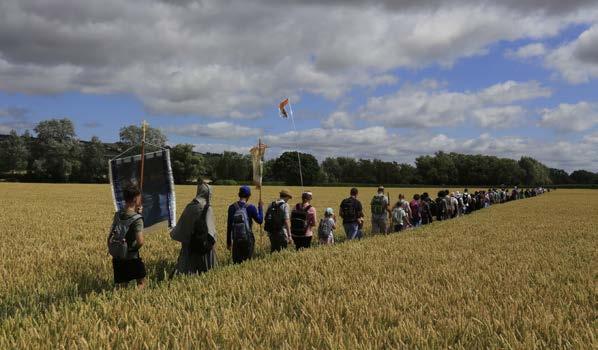
IChristian Jenkins reports from the Pilgrimage of Our Lady of Christendom
n the mists of the old kingdom of Mercia, a humble swineherd named Eof was tending his pigs near the River Avon. Suddenly, a radiant lady, clothed in white and surrounded by an intense heavenly light, appeared to him. Accompanied by two attendants, she asked that the place be made holy to her name.
Eof brought Bishop Egwin of Worcester to the site and he too was granted a vision of the Virgin Mary who again asked for the site to be made holy to Her name. It was the year 702 AD, and in that quiet corner of the Vale of Evesham, Our Lady had chosen to appear. This site - Eof’s ham or Evesham - would become one of the earliest known Marian apparition sites in England.

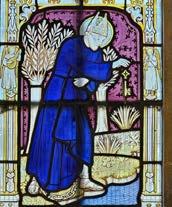
Bishop Egwin, a holy reformer, opposed by some in his diocese, resolved to found a monastery in honour of the Virgin. To seek the Pope’s blessing, he journeyed to Rome and as an act of humility, he bound his feet in shackles and cast the key into the River Avon before setting off.
Upon arriving in Rome, Egwin appealed to Pope Constantine I, asking for recognition of the apparition and permission to build an abbey. The Pope remained hesitant—until a miraculous sign was given. During a meal, a fish caught from the Tiber was served.
When it was cut open, the key to Egwin’s shackles was found inside. Convinced by this divine proof, the Pope approved Egwin’s request. Evesham Abbey was founded with papal blessing, and Egwin was eventually laid to rest in its church. The abbey grew into one of the great Benedictine houses of the land. However, like so many sacred places, its story was violently interrupted at the Reformation, when on 27 January 1540, during Vespers, the monks were expelled. The abbey was dissolved under Henry VIII, and its once magnificent Church became a local quarry. Today, only fragments remain - the Lichfield Bell Tower, two parish churches, and stretches of wall that once surrounded the monastic precinct.
Although the shrine of Our Lady of Evesham is largely forgotten, at Walsingham, England’s national Marian shrine, a list of historic English Marian sites is engraved and first among them stands Evesham. In a land that bears the title ‘Our Lady’s Dowry’, the place of her first recorded apparition clearly deserves to be remembered.
It was with this in mind that a group of pilgrims, inspired by a previous pilgrimage to Covadonga in Spain, came together on 28 June this year to honour Our Lady of Evesham. What began as a conversation among friends became the seed of the Our Lady of Christendom Pilgrimage, and the date was set: 28 June 2025.
Pilgrims walking through the field near the old Augustinian priory at Beckford
© OLC
The Apparition of Our Lady of Evesham in Stained Glass (St Lawrence's Church)
St Egwin drops the key to his chains in the river Avon before setting out for Rome

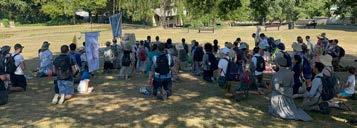
A Day of Grace and Reparation
Our pilgrimage began at Tewkesbury Abbey, in the ruins of its oncebeautiful Lady Chapel - destroyed in the Reformation. A statue of Our Lady, said to be the cause of many miracles, was also lost. With this memory fresh in our minds, we gathered to walk in reparation and in hope.
Eighty pilgrims set off together, families, young and old amongst us, walking through the medieval town under timber-framed buildings and fluttering banners. The sun began to peek through the clouds as we left the streets behind and entered the countryside.
As we walked, we prayed the Rosary, sang hymns to Our Lady, and shared in the silence and beauty. Our first stop came at Beckford, where we paused for rest and shelter in the village hall - by then the sun was strong, and shade was welcome.
At Ashton-under-Hill, we took a longer break for lunch, sharing food and fellowship in the cool of the hall. Throughout the day, we were blessed by the presence of several Marian Franciscan Friars, who offered spiritual encouragement and a tangible witness to Our Lady’s love.
The next stop brought us to the shade of a great yew tree at St Peter’s Church,
Hinton-on-the-Green, where we paused for reflection. The meditation reminded us that Our Lady appeared to a humble swineherd—what wonders might happen if we too listened to her call with open hearts?
The final stretch took us alongside the River Avon—the same river where St Egwin threw his key all those centuries ago. We entered Evesham, weary but joyful, singing Christus Vincit and taking the final steps to the ruins of the abbey. We knelt near the high altar and apparition site, and sang the Salve Regina.
Then, as if in heavenly confirmation, the bells of the Lichfield Bell Tower began to ring—spontaneously, not on the hour. It was a sign to us all that Our Lady was with us, just as she was with Eof and Egwin more than 1300 years ago.
From there we continued to the Catholic Church of the Immaculate Conception and St Egwin, where Fr Lawrence Lew OP offered Mass in the Dominican Rite. The liturgy was enriched by a polyphonic choir, who sang the Te Deum as pilgrims processed into the church. The first-class relics of St Margaret Mary Alacoque and St Claude de la Colombière were also venerated —a beautiful link to the Sacred Heart, so loved by Our Lady.
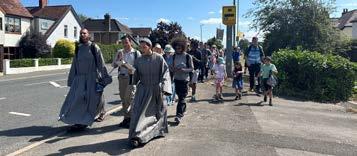
To close the day, a group of pilgrims returned to the abbey site for sung Vespers in the historic Church of St Lawrence—one of only a few monastic buildings to survive the dissolution. It is very likely this was the first public Vespers sung there since the monks were expelled nearly five centuries ago.
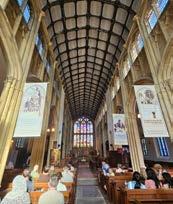
A Dowry Remembered
Fifteen miles. Eighty pilgrims. Blazing sun. Centuries of history. But most of all, a shared desire: to honour Our Lady of Evesham, and to reignite devotion to her in a land that once bore her name.
In this quiet corner of Worcestershire, pilgrims gathered not just to remember a forgotten apparition, but to proclaim their faith—to walk for Our Lady, and for Christendom. In doing so, we joined the long procession of saints and English faithful who have walked before us.
May Our Lady of Evesham once again lead England back to Her Son. Our Lady of Evesham – Pray for us. St Egwin – Pray for us.
Marching to Our Lady © Fr OLC
© Fr Lawrence Lew
Singing the Salve Regina at the Apparition Site in Evesham
Singing hymns through the streets of Evesham


An image of divine love
All Sacraments are an outward sign and symbol of an inward grace, but The Cross goes further, as James Preece explains
Many of you will be familiar with the age-old “gotcha” regarding the omnipotence of God: Can God make a rock so big that He cannot lift it? It would seem that if God cannot make the rock, He is not an all-powerful omnipotent God - but if He cannot lift the rock, well, same problem. Either way, checkmate Christians!
One possible answer to this question is, yes - God can make the rock and lift it and if that doesn't make sense to you then that's your problem because God's logic is above man’s and who are you to question? It's an answer that has never really satisfied me - God has made it clear that He wants to be known and we don't grow in our understanding of God by just saying "oh, it's above us, give it up".
I think this question leads us to a deeper understanding because it touches on something more essential than rocks. Can God limit Himself? Can He create something which is able to contradict His divine will? Anybody who has been to confession knows that the answer is yes, because He created me and I've done some stuff that frankly, a God who is all knowing, allpowerful, and all good would not have allowed to happen.
It’s not that sin is a surprise to God, “whoops, I didn’t expect that” but that He allows this evil (my sins) to exist in order that good (my existence) may come of it, that I may have the free will necessary to freely love Him. But think about what that means. If almighty God limits His power, is He still God? The answer is yes, obviously. Infinity minus one is still infinity - but that minus one represents a sacrifice on His part.
This is why we have to be careful with some theories of atonement. Jesus died for our sins and we can certainly talk in terms of “debt” and His being “punished for our sins” but
this language risks mistaking God the Father for an angry tyrant in need of calming down when in fact it is quite the opposite. Our Lord’s death on the Cross was really the physical incarnation of a deeper spiritual reality - that God gives something of Himself in order that we can live.
‘If almighty God limits His power, is He still God? The answer is yes, obviously. Infinity minus one is still infinity...ʼ
All Sacraments are an outward sign and symbol of an inward grace but The Cross goes further. The water of Baptism and the grace of Baptism are distinct but the God who dies on the Cross and the God who sacrifices some part of His divine will in order that we can exist - it’s the same God. When we look at The Cross we see not only an image of divine love but the mystery at the heart of our existence. God allows sins that He cannot aºllow to exist so that we can exist. The Cross is the reason we have a universe at all.
It is generosity beyond belief that this Sacrifice is made present at every Mass, but Our Lord goes further and invites us to receive Him, Body, Blood, Soul and Divinity in the Eucharist. In the same way that God gives us a free-will veto over His divine will so that we can sin and still exist, so He gives us His actual Body and Blood. It’s both a representation and a reality of the Sacrifice He makes for us. What can we possibly offer in return?
As the Priest says at every Traditional Mass, “Quid retríbuam Dómino pro ómnibus quæ retríbuit mihi?” (“What shall I return to the Lord for all his goodness to me?”). The most precious gift we have from God is His Son Jesus Christ so He is naturally the offering at every Mass, but it doesn’t stop there. We are also called to follow His example and make ourselves a living sacrifice.
If your name is St Thomas More or St Margaret Clitherow that could mean literally dying for the faith, if you are a Priest or Religious you give your whole life for Christ in a special way but I’m going to focus on parents for a moment. As parents we make all kinds of sacrifices literally so that others can live - buying food and clothes, spending money on more shoes than you could possibly imagine or cleaning up something unspeakable.
These sacrifices, if we make them willingly and do not whine like little babies, if we offer them to God in the right spirit - they are of eternal significance. They become as the Catechism of Trent has it, “spiritual sacrifices to God on the altar of their hearts”. So, next time you are up at 3am changing a nappy and losing your cool because you just stubbed your toe in the dark - remember the Cross and “offer it up”.
The Five Wounds
Caroline Farey on the Signaculum Domini and the Monreith Cross
One of the most significant Christian images of the first millennium, following on from early diagrammatic forms such as the XP (Chi-Rho) and preceding the first known crucifix by a hundred years, was the Signaculum Domini. This emblem, known as the sign (signum) or seal (signaculum) of the Lord, was a depiction, in many and various forms, of the five wounds of Christ.
The wounds were usually placed either on the four arms of a cross (usually a cross with arms equal in length, even when placed at the top of a long stone shaft) or in between the arms of a cross. The fifth wound was usually a larger symbol in the centre of the cross, marking the great wound of Christ’s pierced side, soon taken to be his pierced heart.
The five wounds were portrayed most simply and frequently as five dots, circles or crosses. They are also found as five gems, nails, leaves, drops of blood, roses or heart shapes. In stone crosses the wounds of Christ are likely to be the original meaning of the distinctive circular or semi-circular holes separating the arms of the cross.
These semi-circular holes weakened the stone arms which, in Irish Celtic crosses, are strengthened by the added feature of their distinctive circles of stone. When these four holes, or carved indentations filled with raised bosses, are combined with a fifth boss or cross or both, at the centre, the symbolism of the five wounds is complete.
The five wounds were, of course, the direct sources of Christ’s saving blood which ‘sealed’ the definitive act of man’s redemption. Out of Christ’s side-wound flowed blood and water, which St John Chrysostom, already in the fourth century, explains as signifying Baptism and the Eucharist.
Baptism was also known as the Signaculum Dei, the ‘seal of God’ in the early Church. It is not surprising then, that this emblem of the Signaculum Domini, the five wounds, would spread wherever evangelisation and, therefore, the sacrament of Baptism, were taking
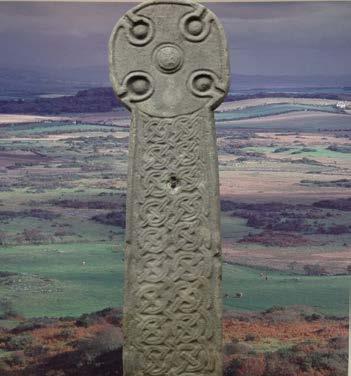
indicate its importance’
place and the establishment of churches for the Eucharist.
The monks of these early centuries knew the Scriptures and would have taught the significance for these Northern climes, as St Paul says, that in Baptism God the Father, ‘has delivered us from the dominion of darkness and transferred us to the kingdom of his beloved Son, in whom we have redemption the forgiveness of sins’ (Col 1:13).
The Monreith Cross
The Monreith cross is from the 10th century, the cross-over period from the native Scots and Picts to the invasion and
settlement of the Vikings across Scotland. St Ninian and St Columba in the fourth and sixth centuries, together with their monks, are credited with the conversion of the Picts whose carved pagan stones gradually changed to Christian crosses.
The Monreith cross is one of several hundred similar crosses of the Viking settlement period suggesting that the Norsemen fairly rapidly converted to Christianity as they integrated with or took over Pictish settlements.
The highly ordered patterns of interlacing are in sharp contrast to the more chaotic symbols and patterns
The Monreith Cross: ‘Looking closely… one can see that the five circular “wounds” are almost a stronger feature than the cross itself, each one with a raised boss within it to
of pagan stones. It is likely that the pagan and Christian symbolism of the interconnectivity of life was similar but brought to a new level of regular order and intricacy by Christ’s divine life given to his body the Church for life everlasting.
This two-meter-high stone is believed to have been sculpted at Whithorn Priory where many similarly carved stones can be found of varying quality, indicating something of a Whithorn school of stone sculpture including apprenticeship. The disc shaped head is distinctive to this school and found in a wide radius of parishes around Whithorn.
Looking closely at the Monreith Cross itself, one can see that the five circular ‘wounds’ are almost a stronger feature than the cross itself, each one with a raised boss within it to indicate its importance. The central boss is the biggest and is clearly carved with a small cross upon it. This is typical in other depictions where sometimes all the raised bosses are carved with tiny crosses.
Whithorn Priory is on the southernmost coast of Scotland facing Northumbria. It is most likely to have been founded by St Ninian in the fourth
century and continued to flourish, including under Northumbrian rule in the eighth century. Northumbria is important because of its great Benedictine monasteries, such as Wearmouth and Jarrow where the Venerable Bede lived, wrote his important histories and died in 735 AD.
All this background shows how extremely likely it is that these Scottish crosses, as for several found in England and very many in Ireland, follow the widespread Catholic practice of portraying the five wounds of Christ as the ‘Seal of the Lord’, the seal of salvation received at Baptism and nourished by the Eucharist.
This emblem of the ‘Seal’ is found marking the parishes around Whithorn, suggesting the establishment of a Church parochial system in that period. These crosses were also used for marking graves as a proclamation of the death of someone baptised into Christ.
However, this particular cross was not found in a religious site but on what is known as Court Hill belonging to the Maxwells of Monreith. It is believed that justice was dispensed at the foot

of this tall stone. Its location and the display of the ‘Seal of the Lord’ suggests that Christianity had penetrated right through to the social justice system of the area and, at least, to the lords of Monreith. The remains of a hole for iron rings are another indication of the judicial use of this particular stone.
Although there is nothing written that I can find concerning these Scottish stones signifying the five wounds of Christ as the ‘Seal of the Lord’, except the book above, I believe this interpretation to be the one with the most evidence, if one takes into account the whole Catholic liturgical and pictorial world of the time.
Factfile
For much of the background on the Signaculum Domini, see The Vulnerary of Christ by Louis Charbonneau-Lassay, translated by G John Champoux, Angelico Press, 2020. For the section on stone crosses see pages 31-33.
A Murderer… and a Saint?
Fr Rupert Allen Cong. Orat. on the life of Jacques Fesch
The process of canonisation has developed greatly over the course of the Church’s history, but it was Our Lord Himself who was the first to declare a person belonging to Heaven – on the Cross, when He promised the Good Thief “Amen I say to thee, this day thou shalt be with me in paradise.”
Devotion to the Good Thief, Saint Dismas, has always been, albeit often quietly, a feature of traditional Catholic piety; one can find amidst the Missae pro aliquibus locis a Votive Mass of the Good Thief granted to be said in prisons on the second Sunday of October. Devotion to Saint Dismas has always been cherished – the promise of salvation to a man whose entire life had been given to sin, but who at the very last made an act of faith and of contrition, who spoke to defend Our Lord, and was promised Paradise.
We are used to saints who have a past; it is a reminder of the grace of conversion for which we all must pray. The Church’s history is full of saints who embraced Christ, even after the most atrocious deeds; becoming a sign of contradiction to the world and to their former life. Yet there is still something which attracts suspicion, or even ridicule, in such cases – from the world or even from Christians. Is there perhaps some ulterior motive for their conversion? Can such a one with a past like that really be a model for Christian perfection?
Such questions arose, and much opposition besides, when Cardinal Lustiger of Paris proposed to open the cause for the canonisation of a young murderer who had been guillotined for his crime in 1957 at the age of 27; Jacques Fesch.
Fesch had been born to a wellheeled family and grown up in great privilege, but without any real direction, much less any instilling of the Faith on the part of his parents.

Fesch continues to inspire hope and faith
He benefited from a Catholic education, but had no real interest or encouragement in his studies and soon gave way to a listlessness that was to mark his life. Fesch began to find distraction in the night-clubs of Paris and rather soon had to civilly marry a young girl with whom he had a daughter. His parents were very much opposed to the marriage – the young girl, Pierrette, was a Catholic like them, but came from a Jewish background, and they were antiSemites.
Jacques and Pierrette had a brief period of something like family life, but Jacques, rather immature, never quite settled into the role of a father and husband and became bored. His mother offered him a million francs to separate from his family and return to her – and Jacques took the money. He bought a sports car and returned to a life without purpose, resorting again to the distractions of Parisian night life – resulting in the birth of another child. Amidst this life without direction or purpose
Fesch dreamt of an escape – he would sail across the ocean and begin anew in French Polynesia. Although he had no experience of sailing, he resolved to buy a boat and pursue his dreams and his escape. His parents were not so keen and so a means had to be found to finance his plan.
On 25 February 1954 Fesch attempted to rob the offices of a Parisian money-changer using his father’s pistol. It did not go to plan, the police gave chase and in the bruhaha that followed Fesch shot and killed a young policeman, leaving the officer’s daughter an orphan. Fesch was arrested and sent to the notorious prison of La Santé. It would be some three years before he came to trial. Initially Fesch rebuffed the approaches of the prison chaplain; he was immersed in self-pity, blaming everyone for his situation but himself. His family did not abandon him and his mother began to send him books to help pass the time. One of these, an account of Fatima, seems to have begun to turn Jacques’ mind to the Faith – he was no longer dismissive of religion, but realised the hope of redemption to be found in Christ. His lawyer, M. Baudet, had himself undergone something of a conversion experience and saw in his young client not only a person to defend but a soul to save.
Jacques Fesch was at last open to the Faith and God would use that newfound receptiveness to enter his soul in a most profound way. Nearly a year after his arrest Jacques received a visit from his wife in which certain matters were revealed to him – we do not know what – which caused him deep anguish. He describes how he returned to his cell: “…that evening I was in my bed, eyes open and I was suffering really for the first time in my life with a rare intensity… and it’s then that a cry sprang from my chest, a call for help: ‘My God!’ and instantly like
Jacques
a violent wind which passes without anyone knowing where it comes from, the Spirit of the Lord seized me by the throat… I really had the sensation that my throat was tightening; and that a spirit went back on itself, too strong for the container that receives it. It’s an impression of infinite strength and sweetness which hasn’t left me since; I believed, and with an unshakable conviction which has never left me.”
From that moment Jacques was converted. His spiritual development was by no means naïve, nor prompted by a desire to help his case, but a gradual process of discernment of the will of God for Him. It was not all riding on clouds; he experienced profound joy at the hope of redemption and the thought of God’s acceptance of his repentance, but so too he struggled with spiritual aridity and a sense of being abandoned by God.
Through all of this he was helped by prayer, the Holy Mass, and the direction of the prison chaplain, his lawyer, and a monk who wrote to him. Jacques used prison as an opportunity to mirror the life of a monk and deprived himself of the few pleasures given to him – cigarettes, biscuits – to enter into the spirit of penance.
Even from his prison cell he became a veritable apostle – doing all he could for the conversion of his family and his fellow prisoners. The guards who kept him under constant surveillance would often find him praying on his knees, rosary in hand, meditating upon the Passion.
It was therefore an entirely different person who appeared for trial. No longer the immature youth caught up in self-pity, but a sincerely repentant Christian whose life had been transformed by the virtue of Hope and the knowledge of God. The trial attracted much coverage in the press – those who lobbied for clemency and others who sought for Jacques to pay the ultimate price. On 6 April 1957 – his 27th birthday –Jacques Fesch was sentenced to die by guillotine. He met the news with joy and resignation.
Jacques had often spoken of his love for the Blessed Virgin and of his devotion to the Little Flower. It seems rather providential then that
‘Jacques Fesch was convinced that Christ had promised him that his penance and conversion were accepted, and that he would enjoy salvationʼ
he was to die on 1 October 1957, the dies natalis of Saint Therese.
The evening before Jacques had been reading the text of the Nuptial Mass from his missal as in his hometown he was married to his wife by proxy before the Church – he had found a new love for her in Christ and desired so much that they be united in Him. He spent the night in prayer and in meditation, praying not only for himself in the hour of death, but for his victims, and for the conversion of his family. When the guards came for him, they found him on his knees in prayer. He confessed to the chaplain and, together with his lawyer, received Holy Communion. Death came quickly then. He was led to the scaffold and with his hands tied behind his back requested a last favour from the chaplain; “The crucifix, Father, the crucifix!” which he kissed tenderly. The blade fell, the sentenced completed, and Jacques Fesch was free.
But it was not the end. Jacques Fesch was convinced that Christ had promised him that his penance and conversion were accepted, and that He would enjoy salvation. His letters from prison, and above all the diary of his last months (published in English this year as I Wait in the Night: The Death Row Journal of Jacques Fesch), enabled many hundreds of thousands to see how God’s grace worked upon the soul of this young man who had been so lost, but who found everything in God.
Jacques Fesch continues to inspire hope and faith for so many, and is an enduring testimony that none of us are beyond the mercy of God. It is never too late for us to turn to God, no matter how far we may have gone from Him; when we turn to Him His arms are there on the Cross, outstretched to welcome us again.
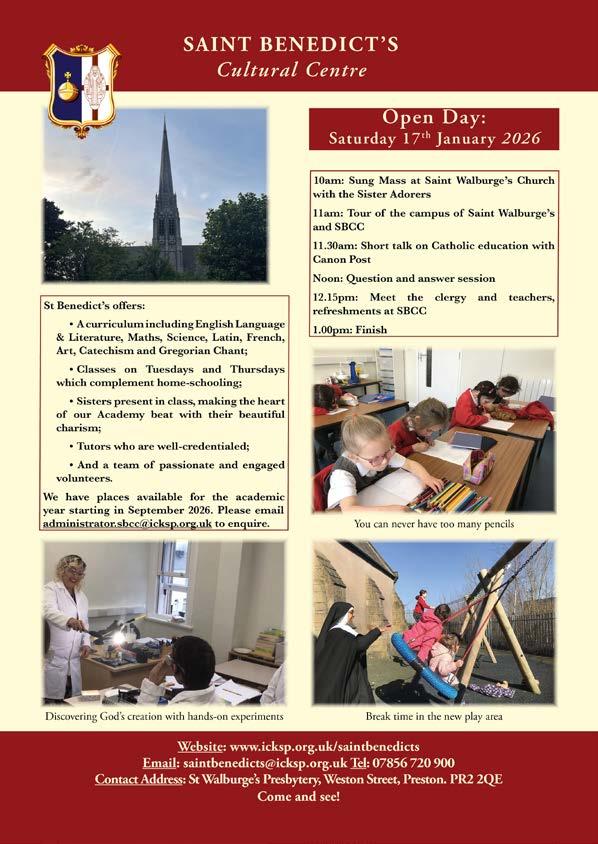
An invitation to readers…
Canon Post on the ICKSP’s forthcoming Preston Open House
“Amen I say to you, if you have faith as a grain of mustard seed, you shall say to this mountain, ‘remove from hence hither,’ and it shall remove; and nothing shall be impossible to you”
Undoubtedly, for many Catholic families in an ever more hostile, secular world, persevering and raising children in the faith may seem as difficult as moving a mountain. Yet God continually uplifts us by His grace and gives us reasons for supernatural hope.
In order to share our reasons for hope, we of the Institute of Christ the King Sovereign Priest would like to invite Mass of Ages readers to join us for an open house in Preston on Saturday, 17 January, beginning at 10am with Mass sung by the Sister Adorers of the Royal Heart of Jesus, followed by tours of the premises and information about Saint Benedict’s Cultural Centre.
The growing Latin Mass community of Saint Walburge’s in Preston, under the pastoral care of the Institute of Christ the King Sovereign Priest, continues to be a place of refuge for families seeking to find like-minded Catholics to mutually fortify their faith. This hope has been strengthened by the abundance of blessings poured out by Divine Providence on the apostolate.
With the support of the Diocese of Lancaster, the ICKSP now manages the extensive campus of the former Saint Walburge’s Parish, with its historic Grade 1 listed church, Victorian presbytery (now a house of formation for candidates to the priesthood), church hall and library, convent and school building.
You will have the opportunity to see the beginning of the next phase of works on the church roof, as well as the restoration of the convent, which will bring our community of Sisters closer to the life of the apostolate, where they sing for the holy liturgy, teach catechism and assist at Saint Benedict’s Cultural Centre. For two years now, our Sisters have also held Saturday activity afternoons for the girls of the apostolate, providing an enjoyable time together of Christian fellowship and a window into the religious life.
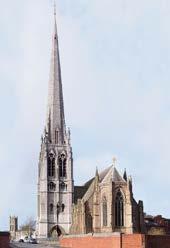
We hope you will join us to get to know better our educational work at Saint Benedict’s - assisting our growing Catholic homeschooling community with the essential task of educating in the faith.
With the presence of both canons and sisters, as well as the dedicated work of lay tutors, Saint Benedict’s offers lessons on Tuesdays and Thursdays in catechism, singing and sacred music, French, Latin as well as support for core subjects.
Thanks to the kind assistance of the Bishop of Lancaster, Saint Benedict’s was formerly housed at English Martyrs’ Church. However, with years of work and generous fundraising from our benefactors, we have been able to restore the former school building at Saint Walburge’s, which we have called home since April 2024.
It is a great joy for us to show this accomplishment to visitors and to witness the potential that these brandnew classrooms offer for the Catholic cultural formation of our youth. The space includes a large room with central
divider, fit both for academic work and for indoor activities, as well as three other classrooms. And since “A sad saint is a sorry saint” in the words of St Francis de Sales, we have also completed a spacious outside play area for the recreation of our children.
A culture cannot be absorbed in one hour per week, but rather must be part of the ambience in which we live, work, play and pray. This is what has drawn so many families from around the United Kingdom and beyond, to join our community. For those also able to join us on Sunday, 18 January, we welcome you to participate in our monthly Guild Sunday. Following the 10.30am sung Mass, families share a packed lunch in the church hall, followed by catechism taught by priests and sisters of the ICKSP.
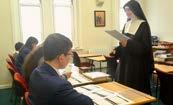
Just as Our Lord required a return on the talents entrusted to his servants in the gospel parable, so we must seek to fructify all that God has given to us, especially the intellects and wills of our young people who will be the future labourers in the vineyard of Christ. These precious fruits are especially remarkable in our vocations; this 6 September past witnessed the first Solemn High Mass of Canon Joseph McCowen at Saint Walburge’s – a returning son of the apostolate. Likewise, we have been consoled this November by the entrance into the priestly house of discernment of an alumnus of Saint Benedict’s. May many other vocations soon follow! Deo Gratias.
(St Matthew 17.19).
St Walburge’s, Preston
Saint Benedict’s offers lessons on Tuesdays and Thursdays in catechism, singing and sacred music
DIOCESAN DIGEST
Mass of Ages quarterly round-up
Arundel and Brighton
Emma-Louise Jay arundel@lms.org.uk
In July Fr Alexander Lucie-Smith celebrated a Requiem Mass for Fr Ray Blake, a priest well-known to his Diocese of Arundel and Brighton. The Mass was celebrated at the Shrine of Our Lady of Consolation, a church which feels as though it floats in the ether of another era and can only be found by the intrepid. On that particular afternoon, cars gushed in from all manner of places and at all angles and with only fifteen minutes to go until the Mass began, they fought politely to find a temporary home in the car park. Inside the church it was very steamy. It was an English summer’s day, the kind of which we don’t always get every year, and whether it was the leaky spiritual atmosphere of the Shrine or the humidity held in place by the architectural splendour there wasn’t a lot of space to be had. I found myself sitting behind a pillar so that I couldn’t see the sanctuary apart from by squinting out of one malfunctioning contact lens which had blurred in the heat.
There were a great many priests at the Mass, including our Bishop Richard Moth, and they sat together in such a way that it was already very moving for us laity to observe before the Mass had started. Once it did start, the rhythm of Fr Alexander’s way of celebrating was so dramatic, and his enunciation so strong that it made little difference that most of us could not see the sanctuary, for we couldn’t miss what was going on and could picture it all pretty well regardless. At Holy Communion, there were two prie-dieu put in place due to the absent altar rail, and so it felt oddly like pairs of newlyweds approaching as people went up for Communion albeit that they separated immediately afterwards. There was no homily, and no eulogy, which was presumably at the request of Fr Blake to place greater focus on the Mass itself. If so, this would be quite a beautiful final gesture towards the world from a priest, I reflected, as his fellow priests lined up in the graveyard and prayers were said against the continuous flow of traffic outside including freight lorries. I did wonder what all those cars felt, watching all of us in the summer heat including a series of priests wellvested and a nun sprinkling dust from a great height, one after another, blessing Fr Blake’s grave with Holy Water. There was a lot of drama about it.
A few days later there was another requiem Mass in the Old form at my parish church in Lewes, and although this Mass had few spectators, the contrast only served to highlight the importance of ongoing provision of this form of the Mass for those who desire it.
We are grateful to have another new server in Lewes (Harry Donovan-Anns) who was baptised here at Easter 2024 and graduated from Bath this summer. There will be a Low Mass at Lewes at 10am for All Saints on Saturday 1 November, and a Low Mass here at 6pm for All Souls (transferred to Monday 3 November). On Christmas Day, the Latin Mass will be at 11am. I understand that there will be some Masses at the Shrine in West Grinstead listed under ‘Events’ on their website, and Masses at Caterham and Molesey will continue; please consult those websites.
Birmingham & Black Country
Louis Maciel 0739 223 2225 birmingham@lms.org.uk birmingham-lms-rep.blogspot.co.uk/
In addition to the usual daily schedule at the Birmingham Oratory, High Mass was celebrated for the Solemnity of the Assumption and the patronal Feast Day of St John Henry Cardinal Newman, soon to be declared a Doctor of the Church. I did forget to mention in my last report a once in a generation High Mass pro Eligendo Summo Pontifice took place on Tuesday 6th May for the election of a new Pope. In addition, the Oratory is providing Latin lessons on Tuesdays at 3pm or Friday at 8pm. We completed nouns and adjectives in the summer term, and have started on verbs in Michaelmas.
The weekly Friday Masses in Wolverhampton continue, and occasionally a High Mass is celebrated, usually when those with associations to the parish return from their studies at the ICKSP seminary in Gricigliano. High Mass was celebrated this quarter on the Feast of the Transfiguration.
The highlight of the quarter, however, has to be the two Masses celebrated in Oscott College Chapel during the WeBelieve festival – see my report on page 10 of this issue.
Birmingham (Worcestershire)
Alastair J Tocher 01684 893332 malvern@lms.org.uk extraordinarymalvern.uk Facebook: Extraordinary Malvern
Traditional Masses continue as previously across Worcestershire. For summary details see the Extraordinary Malvern website but remember it is always best to check locally for the latest information if planning to attend any of these Masses.
June saw the first Our Lady of Christendom UK Walking Pilgrimage from Tewkesbury Abbey in Gloucestershire to the ruins of Evesham Abbey in Worcestershire. For more details see the report from Cardiff-Menevia (Ledbury).
Please remember in your prayers our local priests – Fr Douglas Lamb, Fr Jason Mahoney, and Fr Christopher Draycott – who celebrate Traditional Latin Masses for us and who support us in many other ways; also, Dom Thomas Regan OSB, parish priest at St Wulstan’s, Little Malvern; and last but not least Archbishop Bernard Longley who generously permits these Masses to continue.
Cardiff-Menevia (Cardiff)
Andrew Butcher cardiff@lms.org.uk
Traditional Masses continue to be offered around the archdiocese. On Friday 27th June 2025, the feast of the Sacred Heart of Jesus, I had the privilege of being present at the priestly ordination of Father Illtyd Williams of the Cardiff Oratory in Formation. I have known Father Illtyd for many years, since our childhood growing up in the same street in Cwmbran and on behalf of the Latin Mass Society, I would like to wish him the very best and the assurance of our prayers for the many happy years to come, working in the Lord’s vineyard. Ad multos Annos! Please contact me on cardiff@lms.org.uk if you need any information regarding Mass times.
Cardiff-Menevia (Ledbury)
Alastair J Tocher
01684 893332
malvern@lms.org.uk
extraordinarymalvern.uk
Facebook: Extraordinary Malvern
Regular 11:30am Sunday Low Masses at Most Holy Trinity, Ledbury – the only weekly Sunday Traditional Masses in the three counties of Herefordshire, Worcestershire, and Gloucestershire – continue as normal. That said please do contact us in advance to confirm local Mass times if you intend visiting the area.
June saw the first Our Lady of Christendom UK Walking Pilgrimage from Tewkesbury Abbey in Gloucestershire to the ruins of Evesham Abbey in Worcestershire. Over 75 pilgrims –from infants in backpacks to the over 65s – walked the 16-mile (25km) route on the hottest day of the year, praying the Rosary and singing hymns as they went. The pilgrimage concluded with a Missa Cantata in the Dominican Rite celebrated by Fr Lawrence Lew OP at Evesham parish church of The Immaculate Conception & St Egwin followed shortly thereafter by Sung Vespers back at Evesham Abbey. Pilgrims came from far and wide: Kent, Surrey, Hertfordshire, Gloucestershire, Herefordshire & Worcestershire; and even a contingent of Franciscan Friars all the way from Dundee! Congratulations to Christian Jenkins, from Most Holy Trinity, Ledbury and his co-organisers for organising a marvellous day. It is fervently hoped that this might become an annual event. For more on this see pages 24-25.
As always, please remember in your prayers our parish priest, Fr Adrian Wiltshire, Archbishop Mark O’Toole of Cardiff-Menevia, and all those attending Most Holy Trinity. Also Dom Jonathan Rollinson OSB and Dom Joseph Parkinson OSB who, prior to Traditionis custodes, also celebrated public Latin Masses at Belmont Abbey near Hereford.
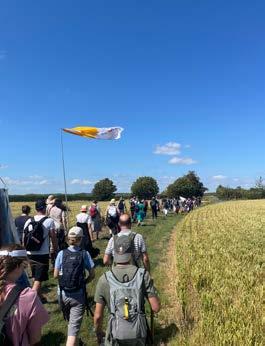
Cardiff-Menevia (Menevia)
Tom and Elaine Sharpling menevia@lms.org.uk
07702230983
We continue to support Canon Jason Jones and Father Rod in their celebration of the Holy Mass in Sacred Heart Swansea and are pleased to see steady numbers in the congregation.
We were also delighted that we were able to have a Sung Mass on Easter Sunday and are grateful to Andrew Butcher who travelled from Newport in order to serve. A new schola has been formed and we are just taking our first steps of singing the Mass – so prayers please!
Our Facebook page has a growing number of followers, and if you would like to connect with us in this way then please contact: StabatMaterMenevia, or give us a call.
We are also grateful to those people who travel long distances to the Holy Mass – you can always be assured of a warm welcome and we are delighted to see new faces.
However, before travelling, check the Facebook page or get in touch so that we can let you know of any changes.
East Anglia (West)
Alisa and Gregor Dick 01954 780912
cambridge@lms.org.uk
Sunday Masses at Blackfriars continue as normal. The dates of future Sung Masses will be posted on the noticeboard in the cloister in due course.
Hexham and Newcastle
John Fagan
hexham@lms.org.uk
We continue to be blessed with provision of Old Rite liturgies across the diocese as per the published Mass Listings but as always please check locally before travelling any significant distance.
On Saturday 19 July Fr Luke Wilkinson celebrated Low Mass in the Chapel at Dilston. On this occasion, this was to meet the spiritual needs of an international Catholic gathering of ‘The Scouts of Europe’: let us hope and pray that, with God’s grace, we will soon be able to report more frequent offering of the ‘Mass of Ages’ both at this old chapel and indeed elsewhere. The chapel has a history which should be of great interest to all Catholics dating as it does from recusant times.
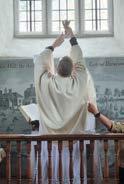
I am informed that the scheduled 12 noon Missa Cantata at St Joseph’s Gateshead on Sunday 21 September, will be celebrated in commemoration of the late, great friend and defender of tradition, Michael Davies. My submission here predates this by a few days, but I hope to be able to fully report, on what I am sure will be a wonderful occasion, in the next issue.
Also, of note and possible interest to readers particularly those within reasonable travelling distance, is the formation of a small group meeting to learn Gregorian Plainchant, at St Joseph’s Gateshead. The group meets every other Wednesday evening, beginners are welcome, and I will be happy to provide further details if contacted as above.
The Old Mass returns to The Dilston Chapel
Lancaster
John Rogan lancaster@lms.org.uk
As ever, there’s much happening in Preston. Jane Latin writes: At the end of June we sadly said goodbye to Joyce Lyons who died after poor health for a number of years. Joyce had been a faithful member of our congregation since the Institute took over in 2014 and a long-time supporter of the Traditional Mass before that. Please pray for the repose of her soul and for Jim, her husband.
July saw the weddings of Matthew and Wanessa, and Benedict and Sian at St Walburge's. We wish them many happy years together.
During the summer we have had visits from Canon Michael McCowen and Deacon James Baxter, as well as Abbés Charles Morris and Thomas Johnson, former Candidates at the House of Discernment and now about to enter their fifth and third years at Seminary respectively.
Following the Institute's Chapter at the end of August there have been clergy changes at St Walburge's. Canon Poucin has moved to the Province in Ireland and Canon Heppelle has transferred to Preston from Belfast. Newly-ordained Canon Bunnens has been appointed as second Assistant Priest at St Walburge's and will join us in October. This means we will now be able to have a Solemn High Mass once again on Sundays. The 6.30 pm Sunday Mass has also resumed, as has the 12 noon Mass on weekdays (not Wednesdays).
At the beginning of September we had the great grace of the First Solemn Mass of Thanksgiving of Canon Joseph McCowen in the presence of Mgr Gilles Wach, Prior General of the Institute of Christ the King. Mass was followed by first blessings of a newlyordained priest. Canon McCowen, together with five of his confreres, was ordained by Cardinal Burke on 3rd July. During that week five seminarians were ordained to the Diaconate and ten to the Sub-diaconate, and a substantial number of young men received the cassock, tonsure or minor orders.
We have now received Lottery funding for the next stage of the roof replacement and this should commence in the autumn. Permission has been granted by the Diocesan Historic Churches Committee North West to return the sanctuary area to its prereordered state and work will also commence shortly. Whilst this is being done, Mass will be said at the War Memorial altar.
Also, work has begun on the renovation of the former convent at St Walburge's. Phase One will be to replace the roof and top floor windows and funding of £600,000 has been secured for this. Phase Two will be to remodel the top floor and funding of around £650,000 is being sought for this. Once these two phases are complete the Sisters Adorers will be able to move from their present home in St Augustine's presbytery. They currently travel twice a day from there to St Walburge's, using time and funds that could be better employed elsewhere. Being on the St Walburge's site will allow them to better fulfil their vocation of Eucharistic Devotion.
At St Walburge's there are many opportunities for the faithful, young and not-so-old, to deepen their faith and strengthen their fellowship. The Sisters Adorers run St Margaret Mary Girls' youth club for girls of 13-18 years on a Saturday afternoon; a Children's Eucharistic Adoration Society has begun on one Wednesday afternoon a month with guided adoration by the canons and sisters and crafts, games and afternoon tea; Guild Sundays return after the summer break and will take place once a month on the second Sunday after the 10.30 Mass. And finally, it is hoped to establish a St Joseph's Boys Club for fathers and sons (7-18 years) to gather and learn about life skills. For dates for all these activities please see the newsletter on the website icksp.org.uk/preston
Finally, for the Feast of Christ the King, we will be welcoming six Candidates to the House of Discernment; five are British and one Irish. Please keep them in your prayers as they embark on the road to the sacred priesthood.
Lancaster
The new term will see Masses on Friday evenings recommence from the week commencing 28th September and, as aver, the public are welcome to attend.
There are changes to parking on campus, details of which are here: tinyurl.com/k7chsbap.
Workington & Carlisle
Masses continue as usual in both Workington and Carlisle, but there’s a change to the phone number for checking Mass at Workington before travelling: 07588 209315. Both Workington and Carlisle easily accessible from the northern parts of the Lake District, so it you’re planning some autumnal walks…

Lancaster (Cumbria)
Nicholas Steven warwickbridge@lms.org.uk
Mass continues to be celebrated at St Margaret Mary's Church, 75 Scalegate Rd, Carlisle CA2 4JX, every Saturday at 10 am. Usually it is a Low Mass with one per month being sung. Thanks are due to Canon Luiz Ruscillo and Fr Paul Harrison, who faithfully celebrate these Masses despite many other demands on their time and attention. Our Schola, led by Andrew Plasom-Scott, recently lost one of its voices, Dawid Klewicki, to the Dominican novitiate and now seeks additional talent.
Our annual Sung Requiem Mass for souls enrolled in the Cumbrian Purgatorial Society – prayforsouls.uk – will be celebrated at Our Lady and St Wilfrid, Warwick Bridge at 10 am on Saturday 8th November (and not at St Margaret Mary's). The Brampton Consort, led by Simon Mortimer, will sing a medieval polyphonic Mass and the propers will be sung by our Schola. A buffet lunch will be on offer, plus an uplifting address and Benediction of the Blessed Sacrament.
Reception of Cross of St Francis de Sales, Preston
Liverpool (Warrington)
Alan Frost
warrington@lms.org.uk
This Report covers the three months beginning in August, during which month St. Mary’s celebrated the Feast of The Assumption with a special evening Sung Mass. The week before (8 Sept.), the Nativity of Our Lady, the Shrine community was dedicated to the protection of our Blessed Mother. Parishioners and visitors were reminded about resting from ‘servile work’, a phrase recalling the formal teaching of The Faith. Also, this year for the Feast the usual Friday abstinence did not apply.
Juventutem changed its meeting date to Saturday, 20 Sept., the same day as for the altar servers’ training. The Archbishop (John Sherrington) urged prayers for the defeat of The Terminally Ill Adults Bill, but its 2nd Reading still got through the Lords. Earlier (Friday 5 Sept.) he celebrated Mass at St. Stephen’s, Orford, and opened a Carlo Acutis Eucharistic Exhibition marking the canonisation of the young Saint in Rome.
Northampton (South)
Barbara Kay 07399 078959
bedford@lms.org.uk
What a pleasant trip across Normandy many of our parishioners had during the first week of September, led by our Chaplain, Fr Armand de Malleray FSSP! Nearly 80 adults and children took part. They saw Mont St Michel, Avranches, Lisieux, Alençon (with holy Mass at the traditional Carmel, followed by a meeting with Mother Prioress – and with Carmel cat “Carmelito”), Caen, Lassay, and more. Meanwhile, back in England, also in September, many parishioners were among the 10,000 people who supported the March for Life in London. Others prayed in Eucharistic adoration at our church that same day for the same pro-life intentions.
Our usual activities resumed after the summer break and here is what Fr de Malleray wrote in the Chaplaincy newsletter at that time:
Our sister congregations in Bedford and Chesham Bois are blessed with many families, young children, couples and single people of various ages. How can we grow further in wisdom, and numbers? How can we best serve the needs of all, and also reach out to share the Good News of Salvation with as many people as possible? It starts with doing well, or even better, what is the backbone of Catholic life: Sunday Masses, weekday Masses, confessions, sacramental preparation, ongoing formation for adults, converts’ instruction.
In support of this, our Sunday and weekday Masses and regular activities continue at the normal times and locations. Please see fssp.org.uk/bedford for details of all our news and forthcoming events. The First Saturday Mass and Marian devotion at Kempson, Bedford, attracts about 80 adults and children. We are delighted that the Scout, Guide, Cub and Wolvet groups are building up nicely with even more exciting activities planned this year, thanks to the devotion of many of the parents. Fr de Malleray is also Chaplain to Regina Caeli Academy UK (rcahybrid.org.uk), our hybrid homeschooling tutoring centre, and he visited there on 22nd September to say a start of term Mass and to bless the children’s backpacks.
Two highlights of this quarter were the confirmation on 4th October of 19 candidates (Bishop David Oakley of Northampton was unable to be present and delegated Fr de Malleray to confer the sacrament) and a privileged opportunity to welcome Bishop Marian Eleganti OSB to Bedford to celebrate a Pontifical High Mass for All Saints at the Shrine of Our Lady of Guadalupe on Saturday 1st November.
Fr de Malleray is the author of several books, and now has his own dedicated website, malleray.com, where you will find reviews, endorsements, and links to purchase his books. Any proceeds are spent in promoting the books and donating complimentary copies to unwaged, seminarians and clergy. Do take a look!
Nottingham Jeremy Boot nottingham@lms.org.uk 07462 018386
A settled period for us. Masses at the Good Shepherd, Arnold, Nottingham, (Sat before 2nd Sundays), Our Lady and St Patrick, Meadows (3rd Sundays), Nottingham, and the Cathedral, Nottingham 3rd Wednesdays continue as scheduled.
On Saturday 12th July (4.30pm) there was a Haydn polyphonic Mass at the Good Shepherd, Nottingham which was very favourably received by the parishioners. Our thanks to the director of music, Mr Robert O’Farrell and Canon Ziomek.
At Loughborough, there are Low Masses each Wednesday at St Mary of the Annunciation 6.30pm unless otherwise stated. We had a Sung Mass for the feast of St John Fisher and St Thomas More, 9th July, the Transfiguration on 6th August, St Pius XII, 3rd September, and Low Mass for Our Lady’s birthday (8th September).
Our sincere thanks to our priests, and to organists, singers and servers all of whom contribute their time so generously.

MassatStMary’sLoughborough
Plymouth (Cornwall)
Stefano Mazzeo
cornwall@lms.org.uk
The Latin Masses at Lanherne Convent Chapel continue to thrive with two Masses on a Sunday at 8 and 11am. Visitors are always welcome to come and swell our congregation. Autumn is always a busy time for the sisters with the apple harvest and cider making and this year looks a bumper one. Please support this young and growing community sisters and chapel if you can. The Sisters of Lanherne are grateful to the Providence of God who supplies their needs through the generous support of the faithful.
Plymouth (Dorset)
Maurice Quinn dorset@lms.org.uk 07555 536579
Dear Friends, the Latin Mass Society’s Pilgrimage to Chideock, in honour of the Chideock Martyrs that took place at the beautiful shrine church of Our Lady Queen of Martyrs & St. Ignatius on Saturday 20th September was, as always, a great success. The relic of the True Cross, at present in the care of the Latin Mass Society, is traversing the whole country as part of this Holy Year’s celebrations, began its tour of the Plymouth Diocese at Chideock, and was venerated after the Solemn High Mass along with relics of the Chideock Martyrs. It was interesting to note that some pilgrims with whom I spoke, had never experienced a Traditional Latin Mass before, but were drawn to Chideock because they wanted the opportunity to venerate the Relic of the True Cross. We have to thank Canons of the Institute of Christ the King Sovereign Priest – Canon Scott Smith (Lanherne Convent, Cornwall) and Canon Scott Tanner (Holy Angels, Chelston, Torquay) – assisted by a seminarian and Institute Oblates in formation (currently at Torquay and at Lanherne respectively), and of course, servers drawn from parishes in Plymouth and Torquay, all of whom added to the reverence and dignity shown at all times on the sanctuary.
We also have to thank the Master of Music, Mr. Andrew Proctor, and the five members of the Southwell Consort who beautifully sang the Mass for us, along with those who gave the talk on the martyrs and on the church itself, and gave a tour of the building taking in the secret Mass chamber in the loft, the beautiful sacristy and the Weld family’s balcony overlooking the High altar.
Thanks also to Fr. Colin Groombridge, PP of Bridport, and to the Trustees of the shrine church, especially to Gaby Martelli and the ladies who untiringly worked to produce lunches for participating clergy and copious amounts of tea and coffee for thirsty pilgrims – myself included! The whole day was a joy, and the date for next year’s 2026 pilgrimage has already been agreed. Unfortunately, though, we are still lacking a priest able and willing to celebrate a regular or semi-regular Traditional Latin Mass for us in this part of the diocese, so if any reader can help remedy this situation please contact me in the first instance and we’ll see what can be done.
Portsmouth
Carol Turner
portsmouth@lms.org.uk
02380273585
Masses continue across the region as usual with a steady increase in numbers. As faithful Catholics, we all deserve a good summer break and can often find parish numbers dip over the holiday months but on the flip side, we have also warmly welcomed many families attending our Masses at St Joseph’s whilst on vacation in the area!
We have been blessed with a dry and hot summer not to mention a plethora of summer activities and pilgrimages in the traditional movement. As I write, I’m not long back from the LMS Walsingham pilgrimage which is always such a joyous event over the August bank holiday weekend. We were joined this year by many of the Franciscan friars on the three-day pilgrimage with early morning Mass being offered before the days’ events commenced. What a wonderful start to the day! A truly grace filled time with many rosaries prayed and hymns sung. For those unaware the walk commences in Ely and continues to Walsingham covering approximately 52 miles (split into three days). Numbers continue to grow each year peaking to approximately 200 this year and I would encourage you to save the date for next year; 28-31 August 2026. This is very popular amongst young Catholics but open to all who feel able to walk! Discount provided for early birds!!
On Sunday 20 July, the Marian Franciscans also organised a one-day walking pilgrimage from Canterbury to Ramsgate. This has become a regular annual event with many pilgrims from all over taking part. There was a great turnout this year with 60-70 pilgrims. We finished the pilgrimage with an evening Sung Mass at the Beautiful Shrine of St Augustine, Ramsgate.
During the month of August, we also celebrated two beautiful feast days, the first being the feast of St Maximillian Kolbe on 14 August followed by the Assumption itself on Friday, 15 August (which I spent at our sister Franciscan friary in Dundee with angelic singing from the sisters). There was an additional evening Mass held at St Joseph’s Copnor at 6.30pm with the blessing of the herbs afterwards and also at Holy Family in Redbridge Southampton at 7.30pm with a procession and blessing of the herbs after Mass.
EF Masses at St Joseph’s, Copnor, Portsmouth continue with a Low Mass at the usual time of 7.00am, Monday to Saturday and a Sung Mass at 11.15am on Sunday. Confessions are usually available either before and/or after Mass. First Friday devotions commence with Mass at 6.30pm followed by the Men’s Group (which includes Rosary, Benediction followed by a shared meal/talk in the hall). We always welcome new members who appreciate the trip to the local for a drink afterwards! On the first Saturday, proceedings start at 9.00am with Rosary, followed by Sung Mass at 9.30am, exposition of the Blessed Sacrament and 15-minute meditation in accordance with the request of Our Lady of Fatima. Confessions are also available. We then proceed to the hall for tea & coffee and lunch usually follows a Marian talk given by one of the Franciscan priests (but sometimes is consumed before the talk!).
At St Agatha’s, Marketway, Portsmouth, a Low Mass is offered by the Marian Franciscans at 8.00am each Sunday. (The last Sunday of the month it’s a Sung Mass).
Holy Family Church, Redbridge, Southampton continues to attract many faithful and a Sung Mass is offered each Sunday at 9.00am. A Low Mass is offered at 7.30pm on Thursday evening (Sung if it’s a Holy Day or feast day). Confessions are usually available before and/ or after Mass. Rosary, Vespers and Benediction are held on Sunday at 4pm.
A Sung Mass at St Thomas More, 42 Exton Rd, Iford, Bournemouth is offered by the Marian Franciscans every Sunday at 12.30pm.
Salford
Alison F. Kudlowski
salford@lms.org.uk
The 1962 Rite (low) Mass continues to be celebrated at the Manchester Oratory on Sundays at 4.45pm
Before this Mass, Vespers and Benediction take place at 4pm. For additional events and regular updates please check the website at manchesteroratory.org, or pick up a newsletter at the church entrance.
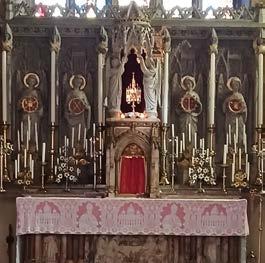
Shrewsbury (Wirral)
Kevin Jones wirral@lms.org.uk
Over the past few months, the spiritual rhythm at Ss Peter & Paul and St Philomena has continued with its characteristic devotion, though not without notable departures from the usual schedule of activities and liturgical programming. These changes have brought both solemnity and celebration, marking a period of vibrant ecclesial life on the Wirral.
On the External Solemnity of Corpus Christi, the Most Blessed Sacrament was reverently carried through the streets surrounding the Shrine. This public witness of faith drew respectful attention from local residents, many of whom paused to observe the sacred procession. A strong turnout of the faithful followed in prayerful adoration, their voices raised in hymns that echoed through the neighbourhood—a moving testament to the enduring presence of Christ in the community.
July brought joyful news from Florence, where ordinations to the sacred priesthood were celebrated in the city's rich setting. Among those ordained was Canon Joseph McCowen, whose journey to the priesthood began at this very Shrine Church, where he worshipped with his family in its formative years. He joins his brother, Canon Michael McCowen, in the growing ranks of the Institute clergy.
During the summer months, the faithful of New Brighton were blessed by the pastoral presence of Canon Michael McCowen and Canon Liam Dodd, who returned to minister during their respective vacations. Their familiar faces brought great joy to the congregation who have witnessed their progress to priesthood.
At the end of August, the Institute held its Annual General Chapter, a pivotal moment in its calendar during which priestly assignments are discerned and announced for the coming year. In Great Britain, Canon Poucin de Wouilt, formerly Assistant Priest at New Brighton, received a new assignment to the Irish Province. As he prepares to take up residence in Galway, the community sends him forth with prayers and gratitude for his ministry.
Meanwhile, within the GB Province, Canon Heppelle and Canon Bunnens have been assigned to serve in Preston, bringing the gift of their priestly ministry to a new corner of the Institute’s mission field.
On 6th September, a dedicated group of Dome of Home regulars journeyed to London to participate in the March for Life. Their presence at this national event underscored the Shrine’s commitment to the sanctity of life and its active role in bearing witness to Gospel values in the public square.
Southwark (Chislehurst)
Christopher Richardson chislehurst@lms.org.uk
Our schedule of Masses, Missa Cantata on Sunday at 11am and in the evenings on Holy Days, and Low Mass on Thursday and Friday evenings, continues. The church is pretty full on Sundays and the congregation continues to grow.
Southwark (Kent)
Marygold Turner kent@lms.org.uk
We have been very lucky with unbroken Masses each Sunday, thanks to our wonderful parish priest and Fr Gabriel Diaz (when he is here).
Our main event has been the Mass at Snave, St Augustine’s a redundant church on the Marsh. We follow the Anglican Harvest Festival by a week so it was clean and tidy for us on 20 September. We are very grateful to the Romney Marsh Historic Churches Trust for welcoming us there. It is a most beautiful church –totally unspoilt with excellent acoustics.
This year we were very glad to have Ben Bevan and his singers again and the music was very fine.
Fr Gabriel Diaz celebrated and many thanks are due to Jonathan Hague and David Hurley who assisted at the altar. Jonathan is extremely kind and very professional, bringing everything needed for the altar.
We had fewer people than before so I do hope next year this annual event will be better supported. It will be our tenth year at Snave, so many thanks to Paul for all his hard work and generosity in funding the wine etc.
The day started very wet but cleared up to be sunny and dry. DG.
Southwark (St Bede’s Clapham Park)
Thomas Windsor claphampark@lms.org.uk
We have some sad news to report, firstly Fr Andrew Southwell has moved out of St Bede’s having had a room here for around two decades. I would like to thank him for all the work he has done building the community, originally as our chaplain and lately as a valuable visitor helping us out in times of need. We will surely miss his presence.
Our second bit of bad news is the second Latin Mass on a Sunday at 12.30pm has been permanently cancelled as part of a reduction of Sunday Masses, this Mass had an average attendance of 35 with highs of 51 and lows of 21 this year.
My last bit of news is for those that travelled here for the Traditional calendar, with the loss of our traditional priest we will now be using a modern calendar on most days for the foreseeable future.
This quarter began with the Feast of SS Peter & Paul where the choir sang a polyphonic Communion, the Tu es Petrus by Heinrich Isaac. For the Feast of St Lawrence the choir sang the Missa O quam Gloriosum est regnum, and the motets Deus tuorum militum and O quam Gloriosum est regnum by Tomás Luis de Victoria. We then had Sung Masses for the Assumption, and St Bartholomew. On the XII Sunday after Pentecost the last Mass here of Fr Southwell, we had the Mass for 3 voices and Ave Verum by Byrd and the Salve Regina, by Palestrina.
This quarter ended with the Feast of the Exaltation of the Holy Cross, the choir sang a setting of the processional hymn Salve Feast Dies for the Holy Cross, the Vexilla Regis, Pange lingua, and Salve Crux Sancta hymns from the Divine Office and the former Sequence Laudes Crucis, during the procession and veneration of our Relic of the True Cross after Mass.
We are still looking for new members to join our choir and with a number of departures we are doing less polyphony. We are also looking for members to join our chapter of the Guild of St. Clare, who have plenty of work to do.
Our catechetical programmes continue on Friday nights, beginning with Low Mass at 6.45pm, we also have First Holy Communion and Confirmation classes for children and a programme for adults. Please check our website / newsletter stbedesclaphampark.org.uk for all our Mass times, catechetical programmes, talks and activities.
Southwark (Wandsworth)
Julia Ashenden wandsworth@lms.org.uk
During this Summer quarter life at St Mary Magdalen’s has continued with the usual regular Masses – the 11am Sunday Missa Cantata, the Tuesday 10.30am, the Friday 7pm and a 7pm Missa Cantata on Holy Days of Obligation or special Feast days.
The Feast of the Assumption which fell on a Friday this year was celebrated beautifully with a 7pm Missa Cantata.
Then on September 14th, the Feast of the Exultation of the Cross, we kept instead our Patronal Feast Day of St Mary Magdalen transferred from July 22nd (because so many parishioners are away on that date). David Guest and his choir sang Mozart’s Coronation Mass, after which we celebrated with the Parish Barbecue!
The First Saturday Masses continue at 10.30am with Confessions and The Rosary beginning at 10.00am.
Our usual heartfelt thanks to Canon Martin Edwards for his unflagging dedication.
Westminster (Cathedral) westminster@lms.org.uk
The departure of Fr John Scott from the College of Chaplains has resulted in the discontinuation of the First Saturday Low Masses at the cathedral. These Masses dated back to the time Cardinal Heenan gained the ‘English Indult’ from Pope St Paul VI and it is hoped their loss is only temporary.
Edward Kendall is moving to Lincolnshire and has stood down as Local Representative at the cathedral. He goes with the LMS’ appreciation and good wishes.
Westminster (Maiden Lane) richard@lms.org.uk
We bad a fond farewell to Fr John Scott, who frequently celebrated the Monday evening Masses at Corpus Christi. He has retired to St Michael’s Abbey in Farnborough. Ad multos annos –and thank you dear Father!
In September we learnt of the death of Fr Patrick Hayward CRL, who for many years celebrated the traditional Mass at the church. A Sung Requiem Mass is being planned but the date has not yet been confirmed. RIP.
The Rector, Fr Alan Robinson, continues to sing the Monday 6.30pm Missa Cantata, accompanied in turn by the Southwell Consort and the Houghton Schola. We have been particularly blessed in this Jubilee Year with music by Giovanni Pierluigi da Palestrina sung by the Southwell Consort as part of their Palestrina 500 Festival, marking the 500th anniversary of the composer’s birth. A full programme of music can be seen at southwellconsort.com.
Corpus Christi is a Jubilee Church and the faithful are able to gain the Holy Year plenary indulgence when visiting.
Westminster (Spanish Place) spanishplace@lms.org.uk
The Sunday 9am Low Masses continue to draw good numbers. On Saturday 6 December the Southwell Consort will hold an Advent fundraising concert ‘A Spanish Royal Christmas’, with renaissance polyphony from the Hispano-Flemish court of Philip II. The concert will be directed by Jeremy Summerly, with soloists Ana Beard Fernandez and Dominic Bevan accompanied by period instruments. Tickets (£15, £20, £25): southwellconsort.com.
Westminster (Willesden) Mauricio Rodriguez willesden@lms.org.uk
Our Sunday and Holy Day Masses continue to be celebrated as usual. There are presently no changes to the regular schedule. At the time of writing, we are especially anticipating the Mass for the Presentation of the Blessed Virgin Mary on the 21st November. This Marian feast will be enriched by the singing of the Southwell Consort who will be visiting us once again. As one of the designated Jubilee Churches of the Archdiocese, this Mass will be our special Jubilee event for November.
We will look into planning further special Masses for the next year. Details will be shared as soon as plans are confirmed. For any questions about Masses at the Shrine, please feel free to contact me.
Gregorian Chant Network
Alastair J Tocher 01684 893332 chant@lms.org.uk gregorianchantnetwork.blogspot.com
The Gregorian Chant Network seeks both to support the development of existing Scholas and to encourage the founding of new Scholas, whether to sing Mass or the Divine Office.
Quarterly workshops, tutored by Dr Matthew Ward and sponsored by the LMS, for the Bournemouth Schola, are scheduled to begin shortly and we look forward in due course to reporting how that initiative progresses.
The Young Adults Group (YAG) at St James's, Spanish Place, London is still seeking new singers. If you might be interested in contribute to their efforts to enrich the liturgy, or if you simply have any questions, please contact Maryam Hoarau at stjamesyamw1@gmail.com.
Details and booking forms for the following chant training days can be found on the LMS website and on the website of the Gregorian Chant Network (gregorianchantnetwork. blogspot.com):
• 20 December, Our Lady of the Assumption, Warwick Street, London; and
• Monthly Chant Days in St John's Cathedral, Portsmouth, from October 2025 to May 2026.
If you know of any other schola or parish which might benefit from expert chant tuition or other support, whether regular or occasional, please get in touch.

India’s Catholic Viceroy
Charles A. Coulombe remembers George Robinson, 1st Marquess of Ripon
The current Indian president and state governors to a great degree occupy the place of the old British Viceroy and provincial governors –often inhabiting the same residences; the mounted President’s bodyguard cavalry units in both India and Pakistan wear virtually the same uniforms and perform the same drill as their mutual parent regiment, the Viceroy’s Bodyguard. But of the 25 Grand Ornamentals who occupied the office of Viceroy from the time the British government took over the country in 1858 until independence in 1947, the most popular among the native Indians was the sole Catholic on the list. This was the remarkable George Robinson, 1st Marquess of Ripon (1827-1909).
The future Marquess was born at 10 Downing Street, second son of Tory Prime Minister Frederick Robinson, 1st Viscount Goderich (who would be created Earl of Ripon in 1833), by his wife, Lady Sarah Hobart, daughter of the Earl of Buckinghamshire. George was educated privately, and attended neither school nor university. Goderich, as George’s father was known, was not a very effective Prime Minister, resigning after only 144 days. Some of the blame – at least in the extended family – was put on his wife, who was of a nervous disposition. She was, however, although Anglican, very much of a Calvinist Evangelical persuasion.
Young George grew up very much under her influence at the family seat of Nocton Hall in Lincolnshire. In addition to his private tutors, he read extensively in the library at Nocton. When he was 17, young George discovered a Catholic Latin Breviary in a bookshop; until his parents objected, he began reciting the daily office.
In 1849 he visited Paris and encountered the worker’s cooperatives set up in the wake of the previous year’s revolution. This was the beginning of his adherence to what was then called Christian Socialism. There was not then anything of Marx, government ownership of the means of production,

or the withering away of the State. Rather, Christian Social thinkers were focusing on how to translate the cooperative ethos of the pre-modern Manor to modern industry – something that would become a motif of Catholic Social teaching later on. Believing that the Upper Classes had a responsibility for the poorer, George determined to show the way.
In 1851, George married Henrietta Vyner, of an old gentry family long established at Newby Hall. The following year a number of important things
happened. His son, the Earl de Grey, was born; he showed the nation his views were sincere by sending £1000 to the strike fund of the Amalgamated Society of Engineers; and he was elected to the House of Commons.
Having an independent mind, and being committed to the establishment of Christian principles in political and economic life, he would never be a reliable party man. In 1858 a series of anti-slavery speeches brought him notoriety. The death of both his father and his uncle the following year brought
Lord Ripon: ‘the most popular Viceroy India ever saw’
him two earldoms making him one of the biggest landowners in the country.
George served in a number of government posts. He was Lord President of the Council 1868-1873 in Gladstone’s first cabinet and pushed for the passage of the Education Act of 1870. This established universal elementary education in Britain and Ireland and supported existing voluntary church schools.
But a personal crisis was brewing, which would lead to his resignation from office in 1873. In April of 1870, his brother-in-law was murdered by Greek bandits while on holiday. The following Sunday, George attended Catholic Mass for the first time at St George’s Cathedral, Southwark. Over the next four years, he began reading Newman, and consulted a Catholic cousin, Lady Amabel Kerr (1846-1906). Born the daughter of the Earl of Cowper, she had converted in 1876, and the following year married Lord Walter Kerr, scion of an old Scots recusant family. She answered a great many of his questions regarding the Faith, and introduced him to Fr John Dobree Dalgairns of the London Oratory, who had been received into the Church with Newman, and entered the Congregation of the Oratory with him in Rome – he was assigned to the London Oratory in 1848.
George’s studies over this period in the end led him to the conviction that the Catholic Faith was true. He wrote to Fr Dalgairns: “Since your letter arrived I have prayed to God to guide me and have very earnestly considered my position, and I can come to no other conclusion than that the Catholic Church is the only true Church of Christ on earth, that it is to her that God has been leading me these last four or five years, and that I have nothing now to do but humbly to ask to be received into her fold. In order that you may be better able to judge how far I am fit, I ought perhaps to tell you that though I think my intellectual conviction of the claims of the Catholic Church is complete, I feel as if my faith were very cold; though I have deliberately made up my mind to take a step fraught with serious worldly consequences to myself, I have not at this moment any feeling of enthusiasm, and the question often rises in my mind whether I really believe anything at all. My answer is that I cannot help believing that God has been leading me very wonderfully during the last few years, and that it is the same Hand which has been guiding me up to this time which is now beckoning me to enter the Catholic Church.”
Lord Ripon now began – as he thought – his permanent official break with public life as part of his conversion. He resigned from the cabinet in 1873, retiring to his estate at Studley Royal. On September 8, 1874, he was officially received into the Catholic Church at the Oratory. At Studley Royal, he set up a private chapel, and paid for the building of a Lady Altar at St. Wilfrid’s Church, Ripon, where he went every Sunday to Mass and Benediction. To his surprise, becoming Catholic meant having to resign the Grandmastership of English Freemasonry, which he had held for four years. To make up for it, he threw himself into the work of the St Vincent de Paul Society, of which he would become president in 1890.
But Lord Ripon returned to public life in 1878. Becoming Gladstone’s shadow Secretary for India, he returned to power with the Liberals in 1880. Gladstone sent Ripon to India as Viceroy, and Ripon took with him to India Fr Henry Schomberg Kerr, SJ, Lady Amabel’s relation by marriage.
Newly ensconced in the Viceregal Palace in Calcutta (now the National Library), Ripon set to work immediately. He ended the war with Afghanistan and recommended coming to an accommodation with Russia in order to end their rivalry. He abolished censorship of the native press and created local government councils across British India for which Indians themselves could vote. He then attempted to permit Europeans to be tried before native magistrates. This caused uproar on the part of British resident in India, and a great many at home.
Ripon defended himself in a letter to one cabinet minister: “The question at issue is not the passing of this particular bill, but the principles upon which India is to be governed. Is she to be ruled for the benefits of Indian people of all races, classes and creeds, or in the sole interest of a small body of Europeans?"
In the end, a compromise was reached in 1883: Europeans could claim a jury at their trials, when tried by a native judge. But as a result, when Ripon left India in 1884, he went with all sorts of awards and accolades from native Indian organizations, and was and remains the most popular Viceroy India ever saw or was to see. He had overseen the start of construction of St Michael’s Catholic Cathedral in Simla, the summer capital of the Raj, although
it would not be completed until 1886. But he came home just in time to share another political crisis: Home Rule.
In 1885, Gladstone committed the Liberals to the policy of Irish Home Rule. While this gained him and his party the support of the Irish Nationalist politicians, it split the party. Ripon supported it wholeheartedly, however, and was appointed First Lord of the Admiralty in the brief Liberal government of 1886.
Two years later, Ripon and another shadow cabinet colleague, were triumphantly received in Dublin and made freemen of the city. In June of that year he wrote: “My Irish work has been of peculiar interest to me, for, apart from the questions with which I have had to deal in India, I have never felt so strongly about any public question as I do about the Irish question. The policy of the government appears to me so blind, so cruel and so hopeless that I am ready to spend myself heartily in the effort to put an end to it.”
Ripon, as the highest-ranking Catholic Peer in Liberal ranks, in 1890 teamed up with his Tory opposite number, the Duke of Norfolk, to successfully support the bestowal of the red hat upon Cardinal Newman.
Two years later Gladstone returned to power, and Ripon was appointed Secretary of State for the Colonies. In 1894, Ripon bought San Damiano Convent near the walls of Assisi from the Italian state which had confiscated it from the Franciscans. He then gave it back to its former owners.
In 1905, Ripon entered the new Liberal Cabinet as Lord Privy Seal and Leader of the House of Lords. Lady Ripon died in February 1907, whereupon he wished to retire. The Prime Minister, CampbellBannerman, begged him to stay on as Leader in the Lords until he himself retired in April of 1908. He resigned the following October as Lord Privy Seal over the mishandling of the Eucharistic Congress of that year – the government responded to protestant protests over a Catholic procession by permitting it but refusing the Blessed Sacrament to be carried or vestments worn.
Ripon died at Studley Royal on 9 July 1909, repeating during the anointing “Jesus, have mercy on me; Mary my protector, pray for me,” as he clasped in his hand the silver crucifix given to him by Bl Pius IX. Nether his wife nor his son followed him into the Church, but he was well remembered as a benefactor by a great many contemporary Catholics.
CALENDARIVM
OCTOBER
Thur 24 St Raphael Archangel
Fri 25 Feria
Sat 26 Our Lady on Saturday
Sun 27 Christ the King
Mon 28 SS Simon & Jude Aps
Tue 29 Feria
Wed 30 Feria
Thur 31 Feria
NOVEMBER
Fri 1 All Saints’ Day
Sat 2 All Souls’ Day
Sun 3 4th Sunday remaining after the Epiphany
Mon 4 St Charles Borromeo B C
Tue 5 Feria
Wed 6 Feria
Thur 7 Feria
Fri 8 Feria
Sat 9 Dedication of the Archbasilica of the Saviour
Sun 10 5th Sunday remaining after the Epiphany
Mon 11 St Martin of Tours B C
Tue 12 St Martin I P M
Wed 13 St Didacus C
Thur 14 St Josaphat B M
Fri 15 St Albert the Great B C D
Sat 16 St Gertrude V
Sun 17 6th Sunday remaining after the Epiphany
Mon 18 Dedication of the Basilicas of SS Peter & Paul
Tue 19 St Elisabeth of Hunagry W
Wed 20 St Felix de Valois C
Thur 21 Presentation of the BVM
Fri 22 St Cecilia V M
Sat 23 St Clement I P M
Sun 24 24th & Last Sunday after Pentecost
Mon 25 St Catherine of Alexandria V M
Tue 26 St Sylvester Ab C
Wed 27 Feria
Thur 28 Feria
Fri 29 Feria
Sat 30 St Andrew Ap
DECEMBER
Sun 1 Advent Sunday
Mon 2 St Bibiana V M
Tue 3 St Francis Xavier C
Wed 4 St Peter Chrysologus B C D
Thur 5 Feria
Fri 6 St Nicholas B C
Sat 7 St Ambrose B C D
Sun 8 Immaculate Conception of the BVM
Mon 9 Feria
Tue 10 Feria
Wed 11 St Damasus I P C
Thur 12 Feria
Fri 13 St Lucy V M
Sat 14 Feria
Sun 15 3rd Sunday of Advent (Gaudete Sunday)
Mon 16 St Eusebius B M
Tue 17 Feria
Wed 18 Ember Wednesday
Thur 19 Feria
Fri 20 Ember Friday
Sat 21 St Thomas Ap. Ember Saturday.
Sun 22 4th Sunday of Advent
Mon 23 Feria
Tue 24 Vigil of the Nativity of OLJC
Wed 25 Nativity of OLJC (Christmas Day)
Thur 26 St Stephen Protomartyr
Fri 27 St John Ap E
Sat 28 Holy Innocents MM
Sun 29 Sunday within the Octave of the Nativity
Mon 30 St Thomas of Canterbury B M.
Tue 31 7th Day within the Octave of the Nativity
JANUARY
Wed 1 Octave day of the Nativity
Thur 2 Feria
Fri 3 Feria
Sat 4 Our Lady on Saturday
Sun 5 The Most Holy Name of Jesus
Mon 6 Epiphany of the Lord
Tue 7 Feria
Wed 8 Feria
Thur 9 Feria
Fri 10 Feria
Sat 11 Our Lady on Saturday
Sun 12 The Holy Family of Jesus, Mary and Joseph
Mon 13 Baptism of our Lord
Tue 14 St Hilary B C D
Wed 15 St Paul , first Hermit C
Thur 16 St Marcellus I P M
Fri 17 St Anthony Ab
Sat 18 Our Lady on Saturday
Sun 19 2nd Sunday after Epiphany
Mon 20 SS Fabian P & Sebastian MM
Tue 21 St Agnes V M
Wed 22 SS Vincent and Anastasius MM
Thur 23 St Raymund of Penafort C
Fri 24 St Timothy B M
Sat 25 Conversion of St Paul Ap
Sun 26 3rd Sunday after Epiphany
Mon 27 St John Chrysostom B C D
Tue 28 St Peter Nolasco C
Wed 29 St Francis de Sales B C D
Thur 30 St Martina V M
Fri 31 St John Bosco C
FEBRUARY
Sat 1 St Ignatius of Antioch B M
Sun 2 Purification of Our Lady (Candlemas)
Mon 3 Feria
Tue 4 St Andrew Corsini B C
Wed 5 February St Agatha V M
Thur 6 February St Titus B C
Fri 7 St Romuald Ab C
Sat 8 St John of Matha C
Sun 9 5th Sunday after Epiphany
Mon 10 St Scholastica V
Tue 11 Apparition of the BVM Immaculate
Wed 12 The Seven Founders of the Servite Order C
Thur 13 Feria
Fri 14 Feria
Sat 15 Our Lady on Saturday
Sun 16 Septuagesima Sunday
Mon 17 Feria
Tue 18 Feria
Wed 19 Feria
Thur 20 Feria
Fri 21 Feria
Sat 22 St Peter’s Chair
Sun 23 Sexagesima Sunday
World News
Paul Waddington takes a look at what’s happening across the globe
As is so often the case, the two biggest stories concerning the Latin Mass to emerge in recent months come from the United States.
Charlotte, North Carolina
Back in May, the Bishop of Charlotte, Rt Rev Michael Martin OFM Conv, announced that Latin Masses would be discontinued at the four parish churches of the diocese where it was being offered. Instead, a single Latin Mass (or perhaps two if required) would be instituted at a new venue in a settlement called Moorsville. It turned out that this venue was a former Freedom Connection Church that the diocese had purchased from a Protestant organisation. The diocese will be spending $700,000 on renovating the premises, and adapting it to make it suitable for Catholic worship.
The changes were to take place on 8 July, although Martin's predecessor, Bishop Peter Jugis, had been granted permission from the Dicastery for Divine Worship for the Latin Masses to continue at the four parish churches until 2 October. The announcement caused a furore amongst supporters of the Latin Mass, including some of the clergy of the diocese. However, in June the diocesan newspaper reported that the changes would be deferred until October in order to give parishioners and their priests more time to absorb the changes.
Reaction against the bishop's plan has been widespread, especially on social media, and was not limited to the four Latin Mass communities. Regina Magazine commissioned a video that investigated how the bishop's actions were received, and the feelings of some of the people affected by his decision. Called Bread not Stones, it was viewed on Youtube tens of thousands of times within a few days.
Bishop Martin has also taken action to eliminate traditional features from Novus Ordo Masses in the diocese. The leaked draft of a document indicated that he intended to ban all use of Latin in parish liturgies, as well as the use of communion rails. More recently, it has been confirmed that in the three schools controlled by the diocese, students will be required to act as Extraordinary Ministers of the Eucharist.
Detroit
Following the Rescript of February 2023, which modified some of the provisions of Traditionis Custodes, many bishops around the world applied to the Dicastery for Divine Worship for permissions to continue Latin Masses at parish churches. In the Archdiocese of Detroit, Archbishop Allen Vigneron sought and was granted permissions for Latin Masses to continue at many parish churches, including 17 where Sunday Masses would be offered. These permissions were all due to have expired on 1 July 2025.
Archbishop Vigneron retired in February 2025, and was replaced by Archbishop Edward Weisenburger. Weisenburger wasted no time in acting to restrict the availability of Latin Masses. In April, he announced that Latin Masses would cease at all Parish Churches in the archdiocese on 1 July, and that the traditional Latin Mass would only be permitted in one non-parish setting within each of the four regions of the archdiocese. These non-parish settings include the large Shrine Church of St Joseph, where the Institute of Christ the King Sovereign Priest offers daily Mass, with three Masses on Sundays.
Archbishop Weisenburger has subsequently gained some notoriety for dismissing three professors from the diocesan seminary.
France
The Priestly Fraternity of St Peter offers the traditional Mass at around 85 locations in France. The majority of these locations are either parish churches, or chapels associated with a parish. Although the arrangement works well at some locations, it does mean that the FSSP has little security of tenure at most of the locations where they operate in France.
For two decades, the FSSP have had a presence at two locations in the Diocese of Valence in south-east France. They have been asked by the local bishop
to withdraw their priest from their mission in Valence itself, although he is happy that they remain in nearby Montélimar. The reason given for the move is that there was local friction caused by the Latin Mass community acting like a “parish within a parish”. A statement by the local Ordinary, Bishop Francois Durand, indicated that Latin Masses will continue in Valence, but will be celebrated by diocesan clergy. The fact that the FSSP will be continuing to offer Latin Masses at Montélimar would suggest that Bishop Durand is wishing to settle a dispute in one particular parish, and has no quarrel either with the FSSP or the Latin Mass itself.
Sweden
Since 2007, a community of Franciscan friars has been offering mid-day Sunday Masses in the traditional rite according to the books of 1962 at their monastery in the town of Jonsored in Sweden. This Mass was in addition to the Novus Ordo Mass that they offered at 10am. Seemingly out of the blue, the following announcement was made in July:
It has recently come to our attention that there may be some tensions or misunderstandings among the Christian faithful in our Diocese regarding the celebration of certain sacraments of the Roman Catholic Church in their various forms. We are concerned that these tensions or misunderstandings may harm the unity of our community. After consulting the Diocesan Bishop, and on the advice of our Minister General, we brothers at the Franciscan Monastery will temporarily cease celebrating Holy Mass according to the 1962 Roman Missal pending further guidance on how to address these tensions or misunderstandings.Wewillcontinue tocelebratetheOrdinaryFormofthe Church's liturgy in our daily Masses. The last Mass in the Tridentine form will be on August 10th.
In the light of the references to the Diocese and the Diocesan Bishop, it would seem likely this decision was not made entirely by the Franciscan community, but that the local bishop was somehow involved. The inclusion of the word, temporarily, would suggest that the withdrawal of this Latin Mass was done with some reluctance.

ANSWERS TO AUTUMN 2025 CROSSWORD
Across: 1 Scherzo 5 Liber 8 Air 9 Extracted 10 Duomo
11 Readjusts 14 Policeman 18 Ghost 21 Alexander 22 Pio 23 Padre 24 Usualis Down: 1 StandsUp 2 Harrow 3 Rhetoric 4 Ottowa 5 Leah 6 Bathos 7 Ryde 12 Jungfrau 13 Stations
15 Legend 16 Moldau 17 Gospel 19 Wasp 20 Lace
Clues Across
1 Nature of the annual Pilgrimage to Walsingham (7)
5 Goddesses of the arts and science in Greek mythology (5)
8 Milk provider (3)
9 Ancient intellectual civilisation incorporated into early Rome (9)
10 Italian city, regional capital of Liguria (5)
11 Conferring honour (9)
14
People who received a Letter from St. Paul (9)
18 Named in baptism by St. Timothy, she is a major Saint of the Greek Orthodox Church (5)
21 Canons Regular Of, also known as the Norbertines (9)
22 ‘The Handle and the ---‘, classic about the Recusants under persecution in England (3)
23 Famous Florida resort with cathedral dedicated to St. Mary (5)
24 See 5 Down
Clues Down 1 Polish birthplace of Pope John Paul II (8) 2 ‘The cattle are ------‘, carol (6) 3 Doctor of the Church who wrote AgainstHeresies (8)
4 Anti-Catholic Riots in London in 1780 (6)
5 & 24 Across: Pictorial representation on stage or film (4,2,5) 6 Acceptable delicacy for meal on Friday (6) 7 Double needlework instruction we hear is just moderate! (2-2)
12 Commercial enterprise (8)
13 Pigs (‘swine’) who were possessed of the Devil and drowned themselves (8)
Saint, mother of Constantine and founder of the True Cross (6)
Nephew’s female relative (6)
Governor who washed his hands of the Truth (6)
‘---- in Alium’, Forty-part motet by Thomas Tallis (4)
‘---- Soit qui Mal y Pense’ Royal Coat of Arms (4)
Entries for the Winter 2025 competition should be sent to the Latin Mass Society, or emailed to info@lms.org.uk, by 7 January 2026. The winner of the autumn Crossword is Mrs Naomi Clear from London. She has won a copy of TheSignOfTheCross by St Francis de Sales.

Alan Frost: November 2025



